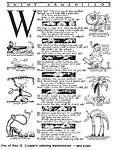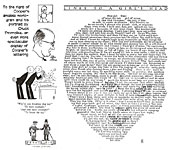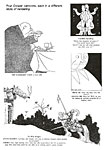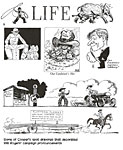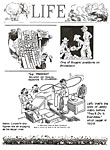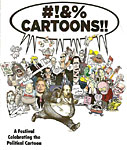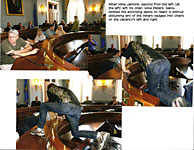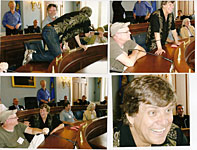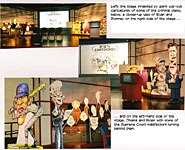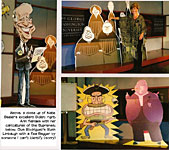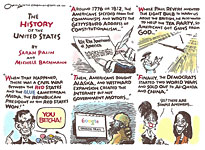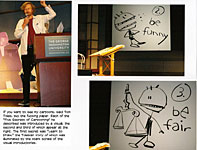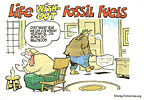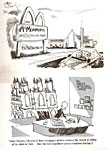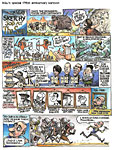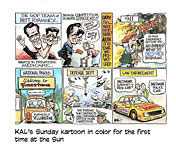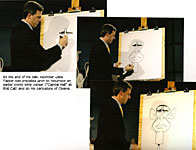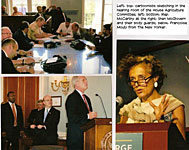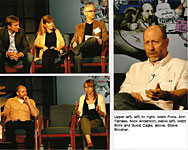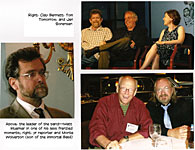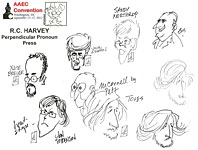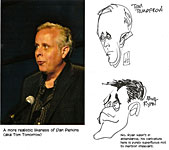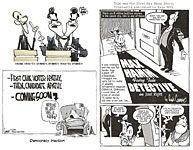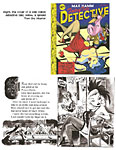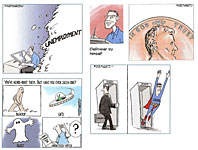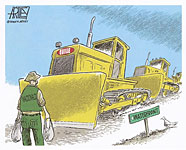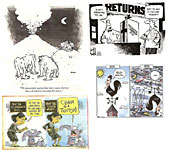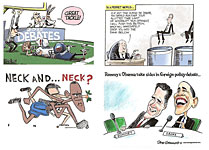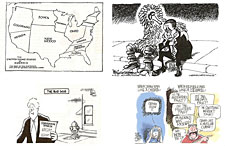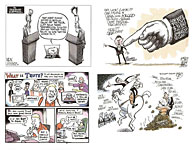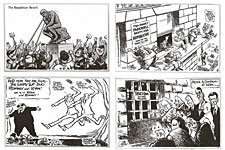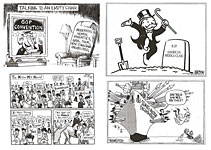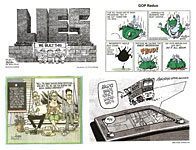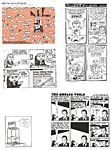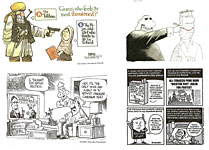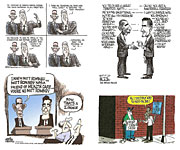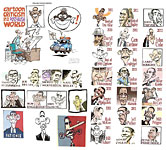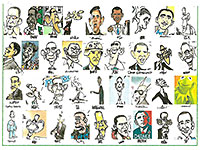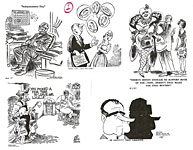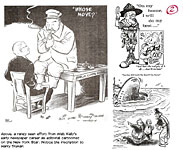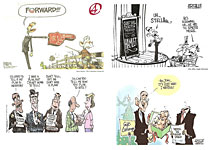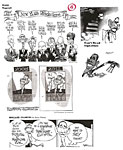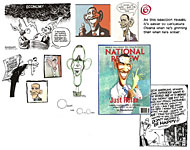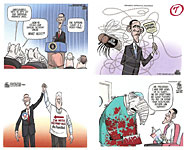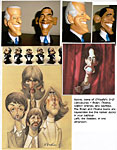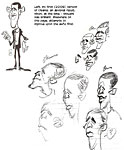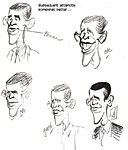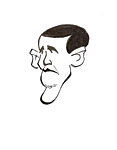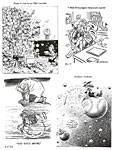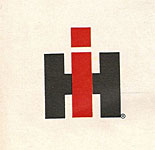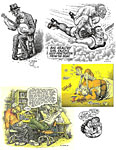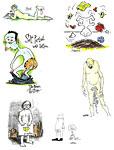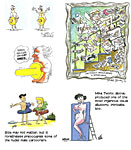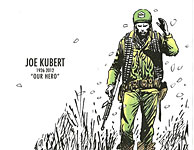 |
|||||||||||||||||||||||||||||||||||||||||
Opus 301 (November 3, 2012). With the Prez Election now in its final, desperate spasm, we devote much of this Opus to destroying Mitt Romney—er, I mean, to dispassionately analyzing the ways political cartoonists have treated the campaign of the last few weeks. This is our Election Issue, the chief purpose of which is to encourage everyone NOT TO VOTE. Voting only encourages what Will Rogers correctly dubbed as the nation’s criminal class (i.e., congresspesons). And think of what might happen if no one voted: no one would be elected! And we’d be spared for at least two years the shenanigans of the crooks in Congress. Not even the Senate could function (not that it has been lately): although only a third of its members are up for election, if the body is missing a third, it may not be able to muster a quorum and therefore could not convene and waste taxpayers’ money anymore. In fact, the money that the government would save in salaries alone—for politicians and their vast staffs—might just wipe out the deficit. The best way to survive the louche onslaught of ego that infects campaigning for election is to point and laugh. And so we’ll begin with a healthy dose of Will Rogers, who knew best how to do the chortling. Before that, though, I want to scratch an itch. At least three times in one week lately, I’ve run across the word louche being used in the public prints. An unusual word. Vaguely foreign-sounding. But not, I submit, the sort of word we’re accustomed to finding in the daily newspaper or, even, a weekly magazine. And yet, all of a sudden, I see louche wherever I look. Who’s responsible for the sudden influx of louche? I looked it up: louche refers to something disreputable or dubious in a rakish or appealing way; something, even, of questionable taste or morality. Ambiguous a little: rakish and appealing, disreputable and questionable morality. All at once? So. There you go. By way of joining the effete scribblers who’ve foisted this shapeless word off on us, I’m going to use it throughout this posting wherever I can find an opportunity. And sometimes, not even then. Perhaps I can beat it to death. No one, after the excess herein, will dare use the word again. And now, here’s a louche list of this posting’s content, in order, by department, as follows—: The Immortal Will NOUS R US New York Comic-Con Clark Kent Quits Daily Planet Barry Blitt’s Romney Reign
EDITORIAL CARTOONISTS INVADE WASHINGTON A Long and No Doubt Tedious Report on the Shenanigans AAEC Awards Cartoonists Rights Network Courage Award Editoonist Layoffs and Retirings
Newsweek To Go Digital in January
EDITOONERY A Survey of How the Campaign Is Faring Under Scathing Pens
CARICATURING BARACK OBAMA How Successful? Or Not?
BOOK MARQUEE Odds & Ends from R. Crumb Changes in the Best Editorial Cartoons of the Year Tome
BOOK REVIEW Naked Cartoonists: Drawers Drawing Themselves without Drawers
Onward the Spreading Punditry More of the Same Balderdash
PASSIN’ THROUGH Marc Swayze Joe Kubert Tribute from DC
Our Motto: It takes all kinds. Live and let live. Wear glasses if you need ’em. But it’s hard to live by this axiom in the Age of Tea Baggers, so we’ve added another motto:.
Seven days without comics makes one weak. (You can’t have too many mottos.)
And our customary reminder: don’t forget to activate the “Bathroom Button” by clicking on the “print friendly version” so you can print off a copy of just this installment for reading later, at your leisure while enthroned. Without further adieu, then, here we go—:
THE IMMORTAL WILL The Man for the Election Season WILL ROGERS HAD THE RIGHT IDEA about politicians and the government they play at and, finally, corrupt. He once pretended umbrage at the antics in the House of Representatives when one of its number objected to another’s quoting Rogers, thereby inserting into the pristine pages of the Congressional Record “the remarks of a Professional Joke Maker.” Well, sniffed Rogers, “can you beat that for jealousy among people in the same line? Calling me a Professional Joke Maker! He is right about everything but the Professional. It’s the congressmen who are the professional Joke Makers. I could study all my life and not think up half the amount of funny things they can think of in one session of Congress. Besides, my jokes don’t do anybody any harm. You don’t have to pay any attention to them. But every one of the jokes those birds make is a law and hurts somebody, generally everybody.” In the same spirit of utter but affectionate disdain, Rogers once ran for the presidency. In 1928, he accepted the nomination from Life (the venerable humor magazine not Henry Luce’s photojournalistic extravaganza), which was acting for the Anti-Bunk Party (“bunk” being the polite term in those days for “bullshit”). Rogers protested that he wasn’t worthy of the honor but then realized that he was accepting only the office of Candidate. Said he: “You know it don’t take near as good a man to be Candidate as it does to hold the office. That’s why we wisely defeat more than we elect.” And he goes on: “I think I can accept defeat in as poor English and with as well-hidden Sour Grapes as anyone you could have chosen. In fact I have already got in my mind the message of congratulation to the winner and am really anxious to hurry up and lose, just to see how it will look in print. When I was thrown out as mayor of a certain alleged town on account of being called a Puritan, when I come out against polygamy, I took defeat without an alibi, which proved that I had none of the earmarks of a politician. I was immediately made president of The Ex-Mayors Association of America—an association, by the way, that will grow: for as long as there is an honest election, there will always be another Ex-Mayor.” Then, he returns to the louche business at hand—campaigning. “I am heartily in accord with the Anti-Bunk Party, but by its very name, it means that we will have no political support. I admit I can make a living outside politics, and when you admit that you can live without depending on politics, you lose right there the support of all politicians.” Addressing Republicans, Rogers said: “We won’t be able to pay you anything for your votes, so that will naturally eliminate all Republican support. And as we can’t pay the Democrats, they will naturally, if they have to vote for nothing, stay in their own party for they have been voting for nothing for years. So offhand, it is hard to see where our support is coming from. “There will also be no promise of jobs,” he continued, “for no defeated Candidate has ever been able to give anyone a job so that is one bit of Bunk that will be eliminated early. Our support will have to come from those who want nothing and have the assurance of getting it.” He concludes by declaring that he has accepted the nomination with one condition, his guarantee that “if elected, I absolutely and positively agree to resign. That’s my only campaign pledge, or slogan: Elect Rogers and He will Resign. That’s offering the country more than any candidate ever offered it in the entire history of its existence.” Life continued its spoof of the 1928 Election by covering Rogers’ campaign through the summer. It published a photograph of the Candidate with a plug of tobacco in his cheek, captioning the picture: “He chews to run.” Prohibition was a big issue in 1928, and Rogers managed to embrace both the pros and the cons while accusing his opposition, Republicans and Democrats, of going around it “like an open manhole.” “The Republicans will try and get by on the old gag ‘we are for law enforcement,’ which means you are as neutral as Switzerland. That don’t mean any more than an aviators’ convention going on record as being in favor of tail winds. ... The Democrats will do something equally as humorous. They will nominate a wet President on a dry Platform, and try and make a voter think he is voting for a ‘dry’ land and a ‘wet’ ocean. “We want the wet vote,” Rogers continues, “and we want the dry vote. We are honest about it; we are not kidding ourselves or anybody, so our plank will run something about as follows: Wine for the rich, beer for the poor, and moonshine liquor for the Prohibitionist. I can’t conceive of any Platform that could more thoroughly touch every class of thought than that one We are appealing to the rich, the poor and to the ‘better element.’ Now if there is any class of voter that we haven’t touched in there, why we would like to hear from him.” Farm relief was also a popular issue talked about that year, so, naturally, Rogers took a stand on it. “I will not only give the farmer ‘relief,’ I will cure him. I will cure him of being a farmer. I will make him so discouraged with life that he will have to open a filling station. There, he can go and sit and watch the rest of the world go by.”
ROGERS’ NUMEROUS CAMPAIGNING ANTICS in Life were brilliantly illustrated by Fred G. Cooper,undoubtedly one of the great unrecognized graphic technicians and comic geniuses of the day. His work is always witty and crisply drawn, and he is often incisively topical. More amazing than this, however, is the enormous range of the man's graphic styles, each deployed with assurance and panache. Born in McMinnville, Oregon, Cooper came to New York in 1904 at the age of 21 after a brief sojourn in San Francisco. His work began immediately appearing in Life and other publications of the day, but his principal income was derived from advertising design. He created the Edison Man trade mark for Consolidated Edison, and his work for that company won him a gold medal for best industrial advertising at the World's Fair in Milan in 1906. He served as the Collier's cartoonist from 1910 to 1920 and as an editor for Life. Cooper was most renowned among his colleagues for his lettering, and his contributions to Life were frequently page-long poems, hand-lettered and artfully decorated with whimsical apostrophes that illuminated other aspects of his subject. He also decorated the editorials in the magazine and was an accomplished caricaturist (as witness his version of Will Rogers in this vicinity, signed, as all Cooper's work was, with a monogram of his initials—a monogram that sometimes sprouted arms and legs the better to cut capers in the corners of his work). Cooper was one of the half-dozen cartoonists whose work regularly appeared on the magazine's covers. And every drawing and cartoon in the February 28, 1928 issue of the weekly magazine was Cooper’s, an unprecedented (and unequaled since) feat. (I’m not sure of the aforecited date; I checked this source once and found it in error, or at least, that’s how I remember it. But I also remember the issue, which I’ve seen; the theme was vaudeville, and all of Cooper’s drawings featured the same antic pair of clowns and/or dancers.) Cooper was an authentic virtuoso whose drawings were always brilliantly conceived and masterfully executed in a pyro-technical display of visual effects astonishing in the variety of their styling. At your visual elbow is a brief sampling of Cooper’s virtuosity—three pages taken from the unpublished third volume in my three-volume Fantagraphics collection Cartoons of the Roaring Twenties, displaying the stylistic variety in of Cooper’s cartoons, his facility with lettering, and his monograph and a portrait of the man himself by Chuck Thorndike, another old gem.
For the Anti-Bunk campaign of Will Rogers, Cooper drew the candidate as a cowboy, adopting a crisp, clean and slender line and splashing a solid black in every so often for the sake of spectacular contrast.
TO ROUND OUT OUR Election Season Survival Kit, here are a few more of Will Rogers’ bon mots about politics and those who commit them—: There is no other business in the world that allows a man to work after he is fired except politics. If some efficiency expert would work out a scheme where each would be paid according to his ability, I think we would save a lot of money. Once a man holds a public office, he is absolutely no good for honest work. If we didn’t have two parties, we would all settle on the best men in the country and things would run fine. But as it is, we settle on the worst ones and then fight over ’em. That’s one peculiar thing about a Democrat—he would rather be told that he is right, even if he knows the guy is a liar, than he would to know he is wrong but belongs to the Republican party. Republicans take care of the big money for big money takes care of them. [It was, it seems, ever thus.—RCH] Elections are like mosquitoes: you can’t very well fight ’em off without cussing ’em. There is no race of people in the world that can compete with a Senator for talking. If I went to the Senate, I couldn’t talk fast enough to answer roll call. A flock of Democrats will replace a mess of Republicans [after the Election]. It won’t mean a thing. They will go in like all the rest of ’em. Go in on promises and come out on alibis.
NOUS R US Some of All the News That Gives Us Fits
NEW YORK COMIC CON drew 116,000 attendees, putting it in a realistic position to rival the Sandy Eggo Con, which shuts down when it hits about 125,000. ... Parade, the Sunday newspaper supplement, was again missing any of its traditional Cartoon Parade feature in the issue for October 7. No cartoons. None. Nada. Sad. Next week, to make up for it, two. Two tiny, postage-stamp sized cartoons. By the end of the month, it was back to one measly cartoon. By now you've likely heard that in the pages of Superman No.13, Clark Kent quits his once-beloved great metropolitan newspaper. NPR’s Glen Weldon reports: “Disillusioned by his employer's increasing predilection for glitzy infotainment over hard-hitting news, Clark takes a principled stand and abandons print journalism for the Web, a medium blissfully free of petty, frivolous, celebrity-driven content.” Among those aroused by this news was an editorial cartooner who remarked: “You know your industry has problems when a comic book creator decides that it is too unrealistic for his character to have a paying job in the newspaper business. Someone actually looked at the Superman comic book and had the following thought: ‘Well, Clark Kent is a benevolent Kryptonian who has x-ray vision and can fly, but what strains our readers’ credulity is the part where he has a paying newspaper job at the Daily Planet. Readers like realism.’”
THE ROMNEY REIGN OF BARRY BLITT Barry Blitt’s
cover on the October 15 issue of The New Yorker is his second cover for
the magazine in three weeks. Then two weeks later, he drew the cover for the
double-issue, October 29 - November 5, bringing his record to three covers in
one month. I doubt that even Rea Irvin, the magazine’s storied first
“art director” (titles were eschewed in those days), had as many covers to his
credit in as short a time. And Blitt also had the cover of the September 3
issue. In his first October appearance on the cover (October 1), he also had a
full-page picture inside, illustrating the louche Mitt Romney biographical
piece. One is tempted to suppose Blitt’s frequent cover appearance is due to the assessment the magazine’s art editor, Francoise Mouly, makes of him as an artist who is as funny in person as he is on paper. Dealing with him, we might playfully suppose, may be a relief from dealing with another artist in her life, husband Art Spiegelman, whose intense seriousness must make Blitt’s alleged humorous demeanor a welcome change. Either that or Blitt is better at drawing Romney than anyone else, a dubious likelihood and one Blitt’s actual artwork denies. All sour grapes, of course: I never sold a cartoon to The New Yorker. But then, I never sold one to Playboy either, and I find nothing on Hef’s magazine's covers to complain of.
EDITOONISTS INVADE WASHINGTON And It’s About Time EXPLOITING
THE FERVID POLITICAL TURBULENCE of the election season, this year’s convention
of the Association of American Editorial Cartoonists (AAEC) was deliberately
scheduled to take place September 13-15, after the nominating conventions of
the two political parties when the antics of editoonists at their drawing
boards could become a louche public spectacle in the form of “A Festival
Celebrating the Political Cartoon.” Staged in Washington, D.C. at the roiling
center of the nation’s political perturbations, the convention by design
invited the general public to attend certain events intended to showcase
political cartooning while providing amusement as well as insight into the
subversive machinations of pandering politicians. Punctuating the event with a suitably festive finale, the presidential suite was raided by the police on a noise abatement errand just after Bruce MacKinnon and the Toon Tones completed an exuberant performance of “Cartoon Blues.” Thus were the unruly ruled: thereafter, into the wee hours, knots and clusters of cartoonists resorted to whispering instead of shouting and singing. The timing and design of the convention were the concoction of AAEC President-Elect Matt Wuerker of Politico, and they were notably successful. Over 100 editorial cartoonists attended (107, to be exact), including 17 international visitors (from Qatar, Iraq, Saudi Arabia, Kuwait, Palestinian territories, Egypt, Uzbekistan, Lebanon, and Morocco), plus AAEC members’ spouses, for a total of 125 registrants. Sale of tickets to public events attracted another 300 persons, tallying a record-setting 425 attendees (not all of whom were present all the time: the 300 ticket-holders came to only those events for which they held tickets). Almost all of the public events took place at George Washington University on Friday and Saturday, but Thursday’s opening session, a panel discussion from the Left to the Right and back again was held in the Madison Building of the Library of Congress at noon. Panelists were Lalo Alcaraz (Pocho.com and La Cucaracha comic strip), Ted Rall (Los Angeles Times), Steve Kelley (New Orleans Times-Picayune), and Scott Stantis (Chicago Tribune). The public audience included a dozen or so eighth graders from the nearby Capital Hill School, who witnessed illustrated talks from Alcaraz and Rall ridiculing the Right, plus more of the same, this time, championing the Right, from Kelley and Stantis. Questions from the audience (among which were several canny adults as well as the attentive eighth graders) provoked admirably defensive responses from Kelley and Stantis. Following a spasm about requiring photo ID of voters and checking suspicious persons’ citizenship papers, Alcaraz quipped: “When they start checking the papers of Irish immigrants, call me.” After a box lunch (sounds cheap, but the boxes offered a variety sandwiches, and mine was purely delicious), the convention moved to the House of Representatives’ Longworth Building and the concentrically arrayed U of desks of Agriculture Committee Hearing Room, where Mike Peters, eager to avoid disturbing a whole row of wedged-in cartoonists in order to get to an empty chair in the middle of the row, climbed over the intervening desk in order to gain the vacant chair.
Almost no one (apart from your intrepid photographer) noticed Peters’ gymnastic, however, because many of the attending cartoonists had unfurled sketchpads and spent an hour sketching each other while awaiting the disdainfully late arrival of two members of the House of Representatives, Jim McGovern, a polite and respectful Democrat from Massachusetts, and California’s louche Kevin McCarthy, House Majority Whip, a Republican whose glib misrepresentations predictably sidestepped the questions he was asked, erecting smoke-screens and impenetrable untruths with every syllable. According to reporter Warren Rojas at Roll Call, the reception “turned from cheery to combative faster than it takes to sketch a Pinocchio nose on an unsuspecting politician.” The congressmen intended to keep it light. McGovern joked about being mistaken as the son of George McGovern, 1972 Democrat presidential candidate (he was still alive at the time of this convocation), and added that what bothered him most about David Hitch, the editoonist at the Worcester Telegram & Gazette, is that Hitch is “really talented.” In the same vein, McCarthy said: “I’ve always enjoyed [political cartoons] because they put a little humor at the same time they state a little policy,” billing the late Rex Babin, the Sacramento Bee’s award-winning cartoonist, as must-read. But the happy talk evaporated once the politicians started fielding questions—all of which were directed at McCarthy. Several cartoonists berated McCarthy for pandering to the Tea Party and for endorsing voter suppression. McCarthy of the silver tonsils deftly avoided answering, shifting the ground of the argument from the issue highlighted by the questions to other, barely tangential, matters and going on about them at great length. But his interrogators were not fooled: they kept repeating the same question. “Is this a top issue with all cartoonists? Because I feel like I’m at a town hall,” an exasperated McCarthy said after 10 minutes of rhetorically jousting with peevish cartoonists. Other would-be questioners urged both sides to get their act together. “Stop this insane back-and-forth between the parties. It’s very destructive to the country,” warned one incensed Oregonian. The insanity, as has been amply demonstrated since this historic confrontation, continues unabated. But it was gratifying to see a double-talking Grandstanding Obstructionist Pachyderm with his feet held to the fire, however briefly. What did he expect anyway? Well-manicured small talk? From those who make a living hurling visual brick bats at public figures?
FRIDAY On Friday, the convention moved to GWU’s Jack Morton Auditorium, where cartoonists took to a stage that had been thematically and technologically equipped for their presentations. Gigantic cardboard cut-outs of caricatures of political figures (Barack Obama, Mitt Romney, Joe Biden, Paul Ryan, Rush Limbaugh, and the justices of the Supreme Court) ringed the stage; at the rear and other both sides, projection screens displayed the visuals of each presentation while the presenters watched it all in a monitor positioned just in front of them. Genuinely high tech.
Many of the presentations were conducted in part for the benefit of non-cartooning attendees unfamiliar with the profession. At the first session, for example, Sandy Northrop and Stephen Hess, authors of American Political Cartoons, 1754-2010, quickly reviewed the history of American political cartooning, and they were followed by freelancer Steve Brodner and Nick Anderson (Houston Chronicle) who demonstrated, respectively, editooning by hand and by Cintiq. After their presentations, they were joined by Mark Fiore (Daily Kos) and Ann Telnaes (Washington Post), and they all exemplified with animated editoons how “the political cartoon evolves outside the box.” Comics journalism was the topic addressed next by Matt Bors (Universal Press Syndicate) and freelancer Susie Cagle, who had been arrested twice last year during Occupy events which local police sought to disperse. She was properly credentialed as a journalist on both occasions, and on the second, was one of several journalists arrested; all but one were soon released, but the louche charges against her from her first “offense” have not yet been officially dropped (although no one is apparently pursuing any legal action either way). In an interview last summer, Cagle talked about journalism and comics: “I’ve been surprised by how so many people still subscribe to the view that a ‘journalist’ comes from a place without an opinion, and, of course, that a journalist cannot be a cartoonist, or vice versa. I think that’s changing and that we’re growing more savvy in our consumption of media, recognizing all the frames and sources of our stories. But until then, a lot of people are uncomfortable with the fact that I have opinions and those opinions are sometimes in the story. For me, it’s a more honest way of reporting. I like to let my readers know where I’m coming from, and I work to not let it affect my gathering of facts.” She said she has always loved what cartoons bring to the journalistic media and regrets seeing cartoons die as newspapers contract. “Those jobs aren’t being replicated on the Web,” she continued, but she also sees opportunities for cartooning on the Internet, especially for reporting breaking news. After lunch, Mike Thompson (Detroit Free Press) and Nate Beeler (Columbus Dispatch) continued the “man vs. machine” motif of two of the morning presentations, offering cartoons both animated and static. Thompson began by reminding us that “the days of holding one job at a newspaper for an entire working lifetime—gone!” Cartoonists should therefore be prepared to move into other modes of cartooning throughout their careers. Next, panelists Clay Bennett (Chattanooga Times Free Press), Jen Sorensen (Daily Kos), and Dan Perkins (aka, Tom Tomorrow of This Modern World), displayed their cartoons viewing campaign 2012 “from the Left.” Later, the view from the other extreme was presented by Nate Beeler, Scott Stantis, and Chip Bok (bokbluster.com). Because the audience was, as usual, predominantly of a flamingly irritable liberal persuasion, the conservative cartooners were forced to defend their views as often as they presented them, which they did with passion, erudition and the usual ideological rigidity. Between these two antagonistic panels, Francoise Mouly, art director for The New Yorker, showed pictures of the magazine’s more provocative covers, described the circumstances that prompted them and the ensuing controversies, and discussed the professional relationship of the artists and the art director (echoing the substance of a recent book of hers, Blown Covers, which we reviewed here in Opus 294). Asked if she was herself an artist, Mouly said she was but not nearly in the same class as those she nurtures as art director. She also confessed that she was married to an artist—Art Spiegelman, who has produced a notable number of the magazine’s most incendiary covers. Friday evening featured “Cartoon Death Match: A Field of Memes ... a wild must-see cartoon smackdown” in which Mike Peters, Jen Sorensen, Mark Fiore and Keith Knight (of K Chronicles and The Knight Life) competed. Emceed by the voluble Todd Zuniga of Literary Death Match fame, the contest concluded with a second round of competition between Knight and Sorensen, during which each of the competitors was given 30 seconds to produce while blindfolded a caricature of one of the “celebrity judges” who were refereeing the event (Gene Weingarten, humor columnist at the Washington Post; and, sitting in for Michelle Obama, Heidi MacDonald, reporter on comics news for PublishersWeekly.com; and the creator of comic book hero Billy Dogma, Dean Haspiel, whose proudest possession is, judging from his frequent flaunting of it, his torso and biceps). Knight, showing an eerie ability to draw Haspiel without seeing, won; and his earlier caricature of Weingarten produced under a 20-second time allowance, revealed a stunning command of this aspect of the cartooning arts. (Haspiel was easy, Knight told me later: all he had to draw was a huge bicep with a small beard.)
SATURDAY On Saturday, the programming unraveled in two strands, both directed at members of a non-cartooning (but interested) public. In the lobby of the auditorium, an exhibit showed how editorial cartoons are created, and an unruly impromptu assembly of cartoonists demonstrated their skills at easels, sketchpads, and wacom tablet. While that was going on outside the auditorium, inside, a somewhat more staid series of individual presentations took place at the steady gait of one every 15 minutes. Matt Wuerker started the latter series with a presentation entitled “Cartoonists: The Original Meme Machines,” during which he explained that the name of the festival, “#!&% Cartoons!” originated with New York’s Boss Tweed in the 1870s. Tweed was being regularly skewered by the cartoons of Thomas Nast, and he complained that he didn’t mind what the newspaper editorials said about him because his constituents couldn’t read, but they could see and comprehend “those damned cartoons.” The poster for the Festival is derived from this historic damnation, and I suppose ordinary citizens could appreciate the “#!&% Cartoons” headline without knowing anything about Nast, but I imagine they wonder who the hell the fat guy running in front of all the caricatures is. It’s Tweed, caricatured by Nast, as any of the louche cognoscenti among us knows (but probably not any great quantity of citizenry otherwise). My guess is that the designers of the poster didn’t really intend “in group” imagery, but that, I suspect, is what they got. In groupiness continued with the deployment here, and elsewhere in the weekend’s program, of the term meme as a satirical slap in the face of a Slate.com writer, Farhad Manjoo, a particularly ignorant would-be critic of editorial cartoons who, in the wake of last spring’s Pulitzer Prize awards, announced, on the basis of his seldom looking at political cartoons, that they could be improved if they borrowed some of the graphic devices seen on the Web, mentioning, among others, memes (such as the iconic image of “The Casually Pepper Spray Everything Cop”), not realizing, apparently, that editorial cartoons are, essentially, memes—except that editoons are often funny as well as provocative. Second at the podium was Rob Rogers (Pittsburgh Post-Gazette) who explored possible alternatives to Uncle Sam as candidates for a new national avatar. After running through a likely list of national quirks and preoccupations, he offered the image of a gorilla. Jack
Ohman (Portland Oregonian) discussed the evolution of style—not
drawing style but manner of visual presentation—concluding with a sampling of
his weekend cartoon that explores a topic in “graphic novel”style. In his fifteen minutes, Lalo Alcaraz, under the heading “Show Me Your Cartoon Papers,” continued his life-long advocacy of immigrant issues. His parents were immigrants from Mexico, and he grew up on the border, where he saw how badly immigrants were treated. At pocho.com, Alcaraz satirizes Latino issues and pokes fun at biculturalism; a recent issue of the Columbia Journalism Review hailed his efforts as being one of the first models for Latino news websites in English. In a voxxi.com interview conducted over the AAEC weekend, Alcaraz talked about which of the presidential candidates is the most fun to draw: “Mitt Romney is easier for me to spoof because obviously I’m opposed to everything he says, and he’s a robot. He’s a human simulation. He’s not real. Obama is tough. Although he’s kind of a wonk and a nerd and that’s kind of funny, but it’s not that funny. Mitt Romney is from another dimension.” Clay Bennett (Chattanooga Times-Free Press) launched into his presentation “Some Offense Intended,” by apologizing if any of his cartoons offended someone but added that if nobody was offended, “I must be doing something wrong.” Joel Pett (Lexington Herald Leader) came on stage next, asking if he was the only presenter who had been cautioned not to use profanity—specifically, the F-word and the C-word. He then recited a host of F-words and C-words, beginning with Fundamentalist Christian and continuing through a list of likewise usually innocuous F- and C-words. The stand-up part of his presentation concluded, Pett also demonstrated how current events can be used in political cartooning, displaying a cartoon in which Republican presidential nominee Mitt Romney is shown competing in an Olympic event, a race he wins because of the prosthetic legs he runs on—bioengineered “blades,” each in the shape of a dollar sign. Pett observed that various of the Olympian fans and/or officials objected to South Africa’s Oscar Pistorius’s running his race on carbon-fiber legs, saying they gave him an advantage. In the enduring competitive spirit of the Olympics, Pett finished, Chinese athletes, in preparation for the next games, will be cutting off their legs just above the knee. The morning series concluded with Tom Toles (Washington Post), who, conscious of an audience among whom were numbered non-cartooning members of the reading (and newspaper buying) public, began with a satirical allusion to the financial plight of print journalism and how it could be solved: “I didn’t bring any cartoons,” he said, “—if you want to see my cartoons, buy the fucking newspaper.” Toles then illuminated “The Five Secrets of Cartooning.” Beginning with the first, “Learn to Draw,” Toles, widely appreciated for the evident lack of drawing ability on display in his cartoons, explained that he can, actually, draw better, but he purposely chose the manner of his rendering, adopting a lumpish style rather than, say, a thoroughly cross-hatched illustrative one. The remaining “Five Secrets” (Be Funny—defining “witty” as “humor without the laughing part”—Be Fair, Don’t Be Stupid, and Don’t Be A Whore) were each introduced with a non-lumpish but barely stick-figurish title slide, which seemed to emphasize Toles’ contention that he could draw in more than one clumsy, amateurish style.
Under
the whoring heading, Toles referred to a cartoon he’d seen just a day or so
before in his paper—a half-page, color cartoon, produced by a political
cartoonist Toles declined to name, who had clearly offered his talent in the
service of the oil industry, thereby creating what Toles called an excellent
example of the worst kind of editorial cartoon—a surrender of integrity to a
whoredom that the craft should not tolerate. David Horsey (Los Angeles Times) kicked off the afternoon session with “How Cartoons Counter Delusions, Misperceptions and Big, Fat Fibs,” concluding the visual portion of his presentation with a cartoon depicting Rush Limbaugh dressed like a floozie and saying, “I’ll do anything for money.” “Perceptions are often wrong,” Horsey said, “—but I hope for a better world” (a better informed one). Nate Beeler (Columbus Dispatch) spoke about the power of art: “The visual dynamic of a political cartoon draws the reader in” to the argument. Gustavo Rodriguez (El Nuevo Herald) illustrated his talk about “cartooning para todos” with his customary array of his delicate linework against brilliant swatches of flat color (like those that defined his caricature of Rush Limbaugh on stage); Brian McFadden, whose altie cartoons have lately invaded the sacred precincts of the New York Times, spoke of “The Future of Freelance: Brought to You by RomneyCare”; Ben Sargent (Austin Statesman) tackled the absurd with a picture of a pipe that is demonstrably “not a pipe”; Jen Sorensen captioned photos from the Democrat National Convention; Patrick Chappatte (International Herald Tribune) advocated animation in cartoon journalism; and John Cole (Scranton Times-Tribune) talked about “the magic of ridicule,” of which he is a master. Pat Bagley (33 years at the Salt Lake Tribune), who describes himself as “Mormon Emeritus,” traced the history of Mormonism as reflected in cartoons, beginning with the particularly nasty efforts in the 19th century to demonize the religion, and including a couple of his own more gentle jibes.
And Kevin “KAL” Kallaugher, who surpasses Bagley with his 34 years at the Economist (albeit a weekly magazine, not a daily newspaper), talked about the mystery and mastery of caricature with his usual flair. KAL, who was laid off in 2005 from the Baltimore Sun where he’d cartooned for 17 years, rejoined the paper in February to do a Sunday cartoon every week. Recently he helped the paper celebrate its first 175 years of publication, and, subsequently, produced his first Sunday cartoon in color—both in evidence near here.
I asked him if he would like to return to the Sun on a full-time basis; surprisingly, he said “no”—he was too busy to take on the work.
ANNUAL AWARDS NIGHT On Saturday evening, following a cocktail hour liberally laced with finger food, the Association conferred awards, beginning with John Locher Memorial Award, presented yearly to an outstanding student editorial cartoonist. This year, it went to Ben Wade, Indiana University at Bloomington. Jack Ohman delivered affectionate (and sometimes profane) remarks remembering his affectionate and sometimes profane friend and past-president of AAEC, Rex Babin, who died last year after a long struggle with cancer. And then the Ink Bottle Award for exceptional service was presented to Robert “Bro” Russell, Executive Director (and co-founder) of the Cartoonists Rights Network International (CRNI) , a non-profit organization, based in the U. S., that protects the human rights and creative freedom of editorial cartoonists by monitoring the fates of those in countries whose government authorities threaten them to prevent them from criticizing the government. Giving international publicity to such official harassments often saves livelihoods and lives. CRNI, acting directly through affiliates, has frequently helped cartoonists find asylum from their persecuting governments. From WittyWorld: Born in New York City in 1942, Russell graduated in 1966 from Syracuse University’s School of Fine Arts, a sculpture and painting major. After a tour in the U.S. Peace Corps in India, “Bro” (as his friends know him) went into international development work and has been a career specialist in developing new and innovative organizations that serve critical human needs. He has lived and worked in Asia and Africa for more than 25 years. With a Sri Lankan cartoonist, he started Cartoonists Rights Network in 1992. CRNI has evolved and grown, now with more than 15 affiliate organizations around the world, including a regional office in Ploiesti, Romania. Bro runs workshops in free speech issues for editorial and social cartoonists, writes extensively about human rights and editorial cartoonists. He keeps his relationships up with more than 50 free speech victim clients who have been assisted by Cartoonists Rights Network over the last 11 years. Every year at the AAEC convention, CRNI presents its Courage in Editorial Cartooning Award to a cartoonist who persists in defying the censorship that his/her government imposes. This year, two cartoonists were recognized: Ali Ferzat of Syria and Aseem Trivedi of India. More about them and what they’ve done down the scroll. Taking to the podium briefly under the punning heading “The Cartoonists Walked up to the Bar” was Roslyn A. Mazer, Counsel of Record for AAEC in Hustler Magazine v. Falwell, the 1988 Supreme Court case that ruled in favor of Larry Flynt’s magazine, which the evangelical preacher Jerry Falwell had sued over a 1983 parody advertisement featuring a fake interview in which Falwell admits that his “first time” was incest with his mother in an outhouse while drunk. The ruling held that public figures cannot circumvent First Amendment protections by attempting to recover damages based upon emotional distress suffered from parodies. The decision in favor of Flynt strengthened free speech rights in the U.S.; AAEC had joined the action in support of Flynt’s rights, and Mazer remembered those efforts and spoke in recognition of “the remarkable role of the Association in protecting satire.” Oddly, according to Wikipedia, after the death of Falwell, Larry Flynt released a louche comment regarding his friendship over the years with the notorious evangelical: "My mother always told me that no matter how much you dislike a person, when you meet them face to face you will find characteristics about them that you like. Jerry Falwell was a perfect example of that. I hated everything he stood for, but after meeting him in person, years after the trial, Jerry Falwell and I became good friends. He would visit me in California and we would debate together on college campuses. I always appreciated his sincerity even though I knew what he was selling and he knew what I was selling." This
year’s keynoter was ABC News’ award-winning Jacob Paul “Jake” Tapper, the
network’s senior White House correspondent. Among his other accomplishments is
the dubious distinction of having produced a political comic strip, Capitol
Hell, for Roll Call from 1994 until 2003, when he joined ABC News.
Declining to predict the outcome of the current presidential horse race, Tapper
talked about the chances for victory of each of the two candidates and finished
by drawing his caricature of President Obama. AAEC President John Cole closed the evening with an invitation to repair to the host hotel’s otherwise deserted rooftop restaurant for a nightcap. When thrown out of the restaurant due to the lateness of the hour (or, rather, the wee-ness of the hour), the carousing multitude found its way to the president’s suite, where it continued, resorting, eventually, to whispered conversation and smothered gawfaws after the police brought a complaint about the noise. The next day (or maybe earlier on Saturday evening), I ran into Pulitzer Prize and Herblock Award winner Matt Davies, loitering in the elevator lobby. He said he’d found the convention invigorating. “This is what it’s all about,” he said excitedly, “—talking among ourselves and seeing what everyone’s been doing. Saturday’s program exactly. Simple. Nothing complicated.” Dispirited after being laid off at the White Plains Journal News two years ago, he said he’s been trying to construct a new career and didn’t know for sure whether editorial cartooning would be a part of it. (At present, his cartoons are syndicated by Tribune Media Services and the Hearst Newspaper Group in Connecticut.) After Saturday’s cascade of presentations, he felt renewed and rededicated himself to continuing in the profession. As for next year’s as-yet unknown convention site—just pick a bar in a central location, he said, and we’ll show up, talking and drawing. For our finale, here are some photos and a few sketches.
SYRIAN AND INDIAN CARTOONISTS’ COURAGE RECOGNIZED Every year, the Cartoonists Rights Network International recognizes a cartoonist who has shown exemplary courage in the face of unrelenting threat, legal action or other pressure as punishment or disincentive for cartoons that are too powerful for some officials, sects, terrorists or demagogues. This year, CRNI recognized two cartoonists: Syria’s Ali Ferzat and India’s Aseem Trivedi. Quoting CRNI board member Matt Wuerker in Time’s issue listing the 100 Most Influential People in the World: “Ali Ferzat, 60, spent years drawing insightful cartoons, mostly staying between the prescribed lines of Syria’s state-sanctioned media. But confronted with the regime’s increasing brutality, he embraced the democracy movement and turned his lampoons on President Bashar Assad directly.” For this, thugs were ordered to send Ali a message: they brutally beat him up, intentionally breaking both his hands. After the attack, Ali made a second courageous and potentially life-threatening decision: he decided to make public what the Assad Regime had done to him. The work of this brave and talented artist can be seen online at ali-ferzat.com/ar/comics.html and on Facebook at facebook.com/ali.frzat. Malaysian cartoonist Zulkifli Anwar Ulhaque, aka Zunar, last year’s CRNI Courage Award winner (see Ops. 300 and 281), accepted for Ferzat, reading the Syrian’s remarks: “I would like to thank the Board of Directors and staff of Cartoonist Rights Network International for this very wonderful award. The other cartoonists who have won this award in the past, and my colleague Aseem Trivedi, who is wining it today with me, are giants in our cartooning world. They are giants in the defense of freedom. It is a badge of accomplishment that I will wear proudly. “What I have learned through my rather unpleasant experience at the hands of the tyrant and his goons, is a difficult lesson. It’s a lesson about bravery and fear. When confronting power and tyranny, you must deal with your own fear. Fear is what the tyrants promote and breed in order to keep our heads bowed, out mouths closed, and our pens doing everything other than what we should be doing. Our humor and laughter to a tyrant is deadly. Fear and Threats are deadly to us. Conquer your fear and you can conquer tyrants. Thank you so much.” Aseem Trivedi, a young cartoonist from India, like Ali Ferzat, made two courageous decisions. First, in an atmosphere of increasing censorship and repression in the world’s largest democracy, Aseem launched the Cartoons Against Corruption website. In an effort to mobilize his fellow citizens against India’s pervasive political corruption, Aseem filled this site with his anti-corruption cartoons. After being charged with treason and insulting national symbols, Aseem took his second courageous act. Despite the charges and threats of additional charges, he has taken a leadership role in India’s emerging free speech movement. Joining forces with other free speech activists, Aseem has launched an online freedom of expression campaign called Save Your Voice: A Movement Against Web Censorship. Susie Cagle accepted for Trivedi. Footnit: A month after the AAEC convention, timesofindia.indiatimes.com reported that the state government has decided to drop sedition charges against the Kanpur-based Trivedi. But the cartoonist will still be charge-sheeted for dishonoring the national symbols, emblem and parliament. Trivedi may be punished with imprisonment for a term extending to three years maximum or a fine or both.
MORE EDITOONIST KNELLS Editoonist Frank Cammuso, who has been cartooning at the Syracuse Post-Standard for 23 years, was one of 115 employees who will no longer be working at the paper after January 31, when the Post-Standard drops to a three-days a week printing schedule. The paper announced the impending change at the end of August and told the axed staffers of their fate on October 1. Interviewed by the DailyCartoonist’s Alan Gardner, Cammuso said his best memories of working at the paper involved covering state politicians, but among those numbered some notable personages: “I’ve covered everyone from Mario Cuomo to Eliot Spitzer to Hillary Clinton. It was fun to have big personalities as targets.” Cammuso said he thinks his editorial cartooning career is over, but he has other plans: “Unfortunately for political cartoonists the writing has been on the wall for a while. I have been writing and drawing graphic novels for the last ten years. Right now it takes up about two thirds of my work time. I have been making the transition for the last few years. This was actually the kick in the pants I needed to make the jump.” And that’s what he plans to do—draw more graphic novels and creator-owned projects. At your elbow are samples of both his political cartooning and his graphic novelizing.
In his editoons, his rendering style veered off into a heavier line recently: I think he shifted from pen (at the lower left) to computer (upper left). His graphic novel series of detective stories about a pig named Max Hamm has become more and more sophisticated in its visuals.
ELSEWHERE, October 12 was the last day at the Albany Times Union for John De Rosier, who has been at the paper since December 19, 1999. He is another casualty in the budget crunch wars. Daryl Cagle posted De Rosier’s comment: “Currently the Times Union is building a new press, so I think many employees were thinking that, although finances are tight—as they are with the entire industry—perhaps the worst was behind us, especially following a much larger layoff several years ago.” That, however, was not the case. Albany Newspaper Guild president Tim O’Brien noted the ironies in De Rosier’s departure: “Last week, employees at the Times Union were very proud to earn the Newspaper of Distinction Award from the Associated Press. A week later, we are eliminating one of the most distinctive elements of our newspaper. Sure, the space can be filled with syndicated cartoons from one of the few newspapers that still employ a cartoonist, but that means fewer and fewer voices skewering our nation's politicians—and no one doing so on a local level.” De Rosier posted his farewell to readers on October 12: “For nearly thirteen years, it has been my privilege to comment on the news as the editorial cartoonist for the Times Union. Due to layoff, my tenure here has come to an end. Thank you all for reading, for your comments pro and con, for keeping me on my toes, and for reminding me daily that my opinion is not the only one worth hearing.” In his post-Times Union career, De Rosier may pursue his avocation as a jeweler. Said he about his unusual moonlighting efforts: “I know. Here's this guy with a cool job and a large audience that reads his opinions and—get this—he's still not satisfied! Really, occupying the editorial cartoonist's post at the Times Union is an enormous privilege, not to mention the fulfillment of a dream that began in high school, so it's a large part of who I am. But my cartoons—by the very nature of the medium—necessarily focus, daily, on what is wrong with the world. I don't mind that because jobs that matter often do precisely that, and by so doing improve the lives of those they serve. “By contrast,” he continued, “my jewelry is my attempt to dwell on what is amazing and beautiful in the world, distill it, and present it as a different kind of offering. Finally, I'm driven to create. Creating reminds me that I am alive and connected to the source of all creation, whatever it is, and in that sense, it's a spiritual pursuit. But we live in a culture that reduces us to the role of ‘consumers,’ and I think we're poorer if we believe it. Too much consuming makes me anxious; I guess it strikes me as gluttonous. I'd much rather be making something of value, building something important, saying something thoughtful, rather than passively using, watching, hearing. Too much consuming, and not enough creating or doing is in my view the grave of the soul, and a shallow one at that.” Here are some of his recent cartoons.
AND THEN WE HAVE THIS from Mike Rhode: Mere weeks after he helped organize the annual meeting of the Association of American Editorial Cartoonists (AAEC) in Washington, DC, second generation editorial cartoonist Steve Artley announced October 19 on his Facebook page that he's retiring from doing them: "My editorial cartoons are no more. I am done, finished, kaput. Earlier today, I stepped down from the Alexandria Times. I guess it's time to try something else. What that something else may be, I don't know. Anyway, thanks to those of you who ‘liked’ my work and left supportive comments." Rhode continued: “In the following discussion, Steve (who is a friend of mine) also noted that he was ‘Tired of being an invisible Quixote. Feel like no one is out there. I make a sound and all I get back is my own echo. Or, I'm a ghost. I cast no shadow. There's no indication of measurable readership, no following, no community support ... I get virtually no feedback, ’cept for the occasional hate mail. All that tells me it's time to go.’ He went on: "Coincidentally, when I called my editor today, he said the mayor had just called, asking, ‘Who is that guy?’ Meaning me, of course, who drew the local issue cartoon that portrayed him as an anthropomorphized bulldozer. I have been there for four freakin' years, Mister Mayor!!!! And only NOW, you notice I'm there? This all underscores that I made the right decision." Right
around here is Artley’s bulldozer cartoon, his last for the Alexandria Times.
AND FINALLY, the other shoe dropped with Jack Ohman. He announced on October 22 that he was stepping down from the Portland Oregonian, where he has editooned for almost 30 years. His announcement was somewhat cryptic— he alluded to “a new chapter” in his career without saying what that might be. Speculation—was he retiring at only 52? was he fired? laid off?—ran rampant for a few days among his AAEC colleagues. And then on October 31, the mystery was solved: he had been hired by the Sacramento Bee. In announcing Ohman’s impending arrival at the paper in January, Stuart Leavenworth, Bee editorial page editor, noted proudly that the paper “has been publishing original editorial cartoons since 1857, when it started publishing.” Ohman, who began editooning at 19, when he was the youngest cartoonist to be syndicated nationally, becomes the fourth staff editorial cartoonist at the Bee since the newspaper hired Newton Pratt in 1939. Dennis Renault followed Pratt in 1971, and when Renault retired, he was replaced by Rex Babin, who came West from the Albany Times Union. Babin, 49, passed away in March of this year after a 15-month struggle with cancer. “While there is no way we will ever forget Rex and his phenomenal work,” said Leavenworth, “I know he'd be proud that the Bee is continuing its cartooning tradition at a time when many newspapers are abandoning it. Babin and Ohman were friends and friendly competitors, both active in the Association of American Editorial Cartoonists. I can't think of a better cartoonist to build on the legacy of Rex Babin.” Perhaps more notable than Ohman’s leaving the Oregonian is the California hiring itself: the Bee is the first major newspaper to hire a full-time staff editoonist since the Chicago Tribune hired Scott Stantis in 2009, which was nine years after position became vacant with the death of the previous Trib cartoonist, Jeff MacNelly. Several of Ohman’s cartoons appear in this posting, so I’m not including any more here. Ohman gave a presentation at the recent AAEC Convention in Washington, D.C.; and you can see a video of him doing it at damncartoons.org.
The Score Now Both De Rosier was listed on the roster of full-time staff editoonists I’ve been keeping score with; Artley was not. So the tally is now 55 political cartoonists working full-time on the staffs of American newspapers. I hasten to add that many more are at work elsewhere—on the Web, in weekly alternative newspapers, through syndication, and freelancing (somehow). The craft and art and attitude of editorial cartooning is not dying: just the newspapers in which the cartoons have historically appeared.
THE FROTH ESTATE The Alleged News Institution AFTER 80 YEARS IN PRINT, Newsweek is joining the multitudes of print publications stampeding into the Internet in an attempt to salvage readership. The news weekly, established in 1933 in louche imitation of Time (which started in 1923), will go to press for the last time for its December 31 issue. After that, it’s all digital. Newsweek almost went under two years ago when its owner, the Washington Post, decided to cease publication. Then in a last-ditch rescue operation, millionaire Sidney Harman bought the magazine for a buck and installed as editor Tina Brown, then (and now, still) editor of the online Daily Beast. Brown converted the news magazine into a dishy political gossip rag with an emphasis on opinion columns (Brown’s forte) and long in-depth stories. It was a lively enterprise, and Time started imitating it (or so it appeared to me, subscribing to both). Oddly, Brown, in her October 22 announcement of the impending change, spent no little energy extolling the magazine’s stupendous recovery under her leadership: “a moribund magazine got its mojo back,” she enthused. Despite all that gloriousness, “when it comes to print, some realities cannot be ignored,” she said. The decisive reality was, apparently, a falling off in advertising revenue. And so Newsweek will join numerous newspapers and other formerly print vehicles in the digital ether. Will it be successful there? I doubt it. Another historic news weekly, U.S. News and World Report, went digital several years ago. Have you heard of it lately? I predict that Newsweek will be swallowed up in less than two years by the Daily Beast, which is, apparently, successful. Meanwhile, Time will march on. And so—strangely, perhaps, unaccountably—will The Week, a weekly news magazine launched just a few years ago with a reporting formula akin to the original Time scheme: the news from numerous sources is condensed and departmentalized for quick reading. In the early years, Time infused its reports with snide opinion sometimes, but by the 1950s, it aspired to objective journalism. The Week devotes half pages to reports of the events of the week, adding opinions quoted from (and attributed to) editors and columnists elsewhere. The Week carries very little advertising, so either it has a deep-pocketed angel somewhere or its newsstand and subscription rates are sufficient to cover its production and distribution costs. Or it’s losing money and deep pockets doesn’t mind. But it’s forging ahead, looking pretty healthy to me. The Week also features a page reprinting a selection of the week’s editorial cartoons and a full-color painted “editorial cartoon” on the cover every week. So if the magazine is thriving, maybe it’s due in some measure to the presence of editorial cartooning. Wow. What a concept.
Fascinating Footnit. For even more comics news, consult these four other sites: Mark Evanier’s povonline.com, Alan Gardner’s DailyCartoonist.com, Tom Spurgeon’s comicsreporter.com, and Michael Cavna at voices.washingtonpost.com./comic-riffs . For delving into the history of our beloved medium, you can’t go wrong by visiting Allan Holtz’s strippersguide.blogspot.com, where Allan regularly posts rare findings from his forays into the vast reaches of newspaper microfilm files hither and yon.
Quotes and Mots from Signs You Can Hang on Your Wall If you stop believing in Santa Claus, all you get for Christmas is underwear. A Meal without Wine is Called Breakfast. I have discovered the Fountain of Youth and it looks and tastes a lot like gin.
EDITOONERY Afflicting the Comfortable and Comforting the Afflicted Nobody can deny, it’s the season for extremes. Surprisingly this time, the October surprise managed to shove the Election campaign off the front pages instead of intensifying the claptrap and balderdash. The news was more momentous than Mitt Romney’s latest louche fabrication, and so political reporters gave up and shut up and started standing in knee deep water in Atlantic City. The tv pundits, however, were not to be outdone or silenced by the biggest, most dangerous and costly storm of the millennium: they plunged immediately into wild speculation about how, or if, the Frankenstorm would affect voting in the next week. They’d talk about skating if hell froze over. By
way of summarizing the events of the last couple weeks, here are three recent
editoons and one George Booth, who, as we can plainly see at the upper
left of our first visual aid, is worth at least three more cartoonists on a
spit. Next on the clock is Dick Locher with a cartoon he drew last spring. If he was weary of the louche liturgism then, what about now? Christmas is nearer, but the weariness still prevails. The most potent of this batch of visual commentary is Kevin Siers with his metaphor of Mitt Romney as a weathervane, which turns whichever way the wind is blowing. On the cartoon’s second bounce, the weathervane, turned upside-down by the force of Sandy’s gale, dramatizes visually Romney’s flip-flop on the importance of FEMA, which he recently said should be disemboweled on the federal level and shipped off wholesale to the states. As we now realize, no state has the financial resources to deal with the aftermath of a natural disaster of the dimensions the hurricane that struck New York and New Jersey, whose governors are happy to accept FEMA’s help. (And New Jersey’s Chris Christie was all over television—even on FoxNews—with praise for the way Prez Obama was dealing with the crisis. All of Obama’s minions and marketing experts could scarcely devise a better tv ad.) Finally, here’s Daryl Cagle with a little dramatization of how FoxNews reacts to whatever potentially political news manages to float over the transome into its maw. The one-two punch demonstrating the knee-jerk response of the li’l pachyderm made me laugh out loud. And it’s the sequence of images here that makes Cagle’s point: one of these panels alone would not achieve the objective, and the succession of images and the echo of their composition creates a sense of rapidity that underscores as it creates the message. Nicely done. Until the advent of Sandy the Superstorm, the politics of the Election Year dominated the news regardless of how inconsequential the actual political news was. And now that the last of the laughably labeled “Presidential Debates” has taken place and we are on the cusp of committing another national election, we offer here at Rancid Raves a succinct assessment of the state of the contest and the qualifications of the principal combatants. The third and last debate between the Prez candidates was won by Barack O’Bama “on substance,” Dave Letterman reported. “So what’s that mean?” Dave went on, sputtering. “Lance Armstrong won on several substances—and look what happened to him.” Lance Armstrong has always seemed to me a suspicious character. His name, f’instance. “Lance Armstrong.” Armstrong? That’s a weight-lifter’s name, not a cyclist’s. Lance? Really? Do you know anyone who would name their child “Lance”? (Except maybe Mitt Romney, who, to get even doubtless for his own off-beat first name, christened his first-born Tugg. And then there’s Sarah the Palin’s names for her offspring. Oh, and a couple of FoxNews personalities—Trace Gallagher and Harris Faulkner. Or is it Faulkner Harris? If you think I’m envious, you’re right.) No matter, the whole Lance Armstrong thing, from L to G, seems made up to me. It’s the name of a comic book character, not a world champion athlete. Lance’s been stripped of his titles. And no one will take his place in the Tour de France’s louche record book. Seven lines of blanks. Said Tour honcho Christian Prudhomme: “For us, very clearly, the titles should remain blank. Effectively, we wish for these years to remain without winners.” None of the runners-up will move up the ladder to occupy Armstrong’s vacated spot: turns out most if not all of them were dopers, too. So why not let “Lance” keep the titles? He won them fair and square in open competition with other dopers. The competition, in other words, took place on a level playing field, insofar as all the competitors were equally doped up. But what do I know? Anyhow,
I divaricate. Return with us now to the thrilling evening of the third bout
between Obama and Romney, the man who believes in only one thing: his most
passionately held belief is that he should win. That he deserves to win. In
short, his deepest emotional attachment is to winning. Says Hendrik Hertzberg
in The New Yorker: “All the evidence indicates that Romney has no ‘core
beliefs’ beyond a gauzy assumption that the business of Ameria is business and
an unshakable, utterly sincere conviction that he, Mitt Romney, ought to be
President.” (Throughout the debates, whenever he was not talking—which wasn’t
that often—Romney stared benignly at Obama and, as one wag observed, assumed
the expression of a man who has just thrown his shoulder out.) We start off with Eric Allie’s gridiron metaphor at the upper left. Allie often veers off to the Right, it seems to me, but this cartoon is reportorial rather than adversarial. I admire Allie’s drawing style so I wish I agreed with him more. Next on the clock is Randy Bish, who comments on the sometimes ungentlemanly behavior of the debaters with a picture that must represent the moderators’ fondest dream (and that of many of the audiences, too, forsooth). The loser and winner of the moderating role begins with PBS’s Jim Leher, who maintains that being beat up by Romney’s rudeness was worth it because he achieved what he wanted—a free exchange between the candidates. Yeh, but—but how, if the moderator retreats, do you shut Romney up enough to let Obama speak? The winning moderator was clearly Martha Raddatz, who even won the admiration of the seldom (if ever) admiring Will Durst, who conferred kudos galore for “refereeing the event with a command and aplomb that had veteran observers refer to her as the anti-Jim Lehrer. She actually seemed to listen to the responses at this debate and called candidates out when they tried to weasel away.” She asked penetrating questions and took no guff from either of the veep debaters; she shut down logorrhea at its first offense and kept after the offender. Candy Crowley held her own (particularly in offering up an actual fact that shut Romney’s mouth on the Benghazi brouhaha); ditto Bob Schieffer. But no one did better than Raddatz. Dave Granlund’s picture of the two candidates is the most accurate visual characterization of the third debate I’ve seen. And Randall Enos provides the most vivid image of the state of the Race as October fades out. If Romney wins by a nose, it’s Pinocchio’s proboscis of prevarication that will have assured the victory.
THE LOUCHE STATE of the Chief Executive Horse Race has been an all-consuming preoccupation of the so-called news media, which has studiously avoided pursuing any serious questions that the candidates should be addressing—the fiscal cliff and how to avoid falling off it, global warming and how to live with it, the impossibility of a two-state solution to the Israeli-Palestinian predicament (and what to do instead), how to ban weapons of mass destruction in the U.S. when the nation is being run by Tea Baggers who are packin’, what to do when a cyberassault shuts down the entire country with a virus that undermines the computer foundation upon which all else rests these days. Nope.
Nothing can displace in the news media’s ever evaluating eye the Global
Importance of the Standings in the Horse Race. In the first cartoon in our next
visual aid, Jack Ohman’s image provides the most succinct comment on
this misbegotten aspect of the campaign. At the upper left, Ohman’s map of the United States reveals that only eleven states actually count in the Election, a stunningly direct indictment of the Electoral College system by which Prezes are elected (270 votes are needed for victory). Given the political predilections of the citizenry elsewhere, pundits nationwide have determined that the Election has been decided in all those other 39 states. But since Ohman drew his map, the pundits have been constantly taking pulses and pawing through tea leaves, and they now, as of the day after the Last Debate, have determined that there are only seven—or maybe only six—states in which the outcome is in serious question. Or maybe fewer. In an appearance with David Letterman, Rachel Maddow said she thought maybe Ohio would decide the Election. A few days later, one of the weekly newsmagazines concurred. And then along comes the Associated Press on October 22 or thereabouts, claiming that out of 3,031 counties nationwide, only 106 counties in nine critical states in the nation are up for grabs. The computer-assisted science of electoral demographics has been so refined that the outcomes in nearly every county in the country can be confidently predicted. Only 106 cannot be predicted. So those 106 will decide the Election. In Ohio, one of the critical counties is Hamilton County where “tony suburbs around the humming riverside economic engine of Cincinnati may tip the balance in Ohio.” My speculation in Opus 298 has come true. First the science of demographics decides that in only a few of the 50 states is the outcome not a foregone conclusion. Next, I opined, we’ll be able to reduce the undetermined population to those in certain counties. (Which, as you can see, has already happened.) Then in certain towns in those counties (ditto); then in certain neighborhoods in those towns; and, finally, to certain families in those neighborhoods. In the ultimate triumph of political demography, we will soon be able to determine which person in the decisive family is the one whose vote will swing the Election this way or that. That person will be showered with campaign money and will become very rich and retire to the Cayman Islands. But the rest of us will be spared months—nay, years—of political campaigning with its tiresome double-talking, lying, misrepresenting and fact-checking. We’ll be a grateful but politically impotent population. Until that happy day, however, we’ll still have years of bloviating candidates to endure and Prez Debates to witness. Incidentally, if you want to navigate around my tirades and get to just the editorial cartoons I’m ostensibly spotlighting, I’ve installed typographic guidesposts that will help you avoid the noise and alarm. Discussion of each new cluster of four editorial cartoons is introduced by a flush-left all capital letters phrase—like DEBATING THE TRUTH below. So when you find yourself in the grip of another of my jeremiads and want to escape, just scroll down to the capitalized phrase, which will introduce a new, less inflammatory elucidation. Easy, eh? Boy, are we thoughtful or what. Moving clockwise on the visual aid that we’ve left languishing, we come to Milt Priggee’s assessment of the outcome of the first Debate. Big Bird got all the comment among the pundits, so he is the logical one to comfort the loser, Prez Obama: both were riddled by the Romney who showed up that evening. And Big Bird is the emblem of Romney’s victory. Next on the clock, we have Pat Bagley’s insightful comment on the political climate in the louche aftermath of each Debate. Another vividly accurate insight, seems to me, although not a particularly visual one. And finally, leaping back into early September at the Democrat Convention in North Carolina, here’s Chan Lowe, whose visual metaphor shows us just how important Bill Clinton’s speech was: on the fire hydrant is this legend: GOP Trickle-Down Argument.
DEBATING THE TRUTH might be the heading for the next few editoons.
In our first example, Kirk Walters isn’t using a metaphor or a telling image, but by bringing back Ross Perot in the Prez Debate, he reminds us of just how shallow the issue-avoidance “debates” are. And we need reminding. Next around the clock, Pat Bagley returns to give the finger to GOP witch-hunters who are trying to pin the blame for the murders at the consulate annex in Benghazi on Obama. The actual culprit is the Grandstanding Obstructionist Pachyderm which cut off funding for embassy security. Again, the image is not so very telling; but the Truth being told is telling enough without pictures. Several exculpatory elements obtain here. First, security at national embassies in foreign climes is traditionally the function of the local government, not of the embassy personnel or of the nation it represents. Secondly, since funding had been cut, the logical reaction of the State Department (which is responsible for our overseas embassies) is to pass requests for additional security on to the host nation. Third—which may account for the Obama Administration’s seeming inconsistency in calling the assault an act of terror (although Prez Obama did just that the next day)—is the presence near the consulate annex of a CIA installation. Every nation in which we have an embassy doubtless suspects (to the point of certainty) that CIA agents are part of the embassy staffing. But it’s possible that the terrorist act in this case was directed at the CIA, not the USA. Calling the assault an act of terror might have led to questions about why—and those might have blown CIA’s already largely fictitious cover. (Fictions of this sort are the stuff of international diplomacy so don’t knock them.) So after a few days, Administration officials started backing off the terrorist claim, hoping to keep the CIA out of the discussion. But then GOP congressmen on the House committee investigating the incident pounded State Department officials with questions that revealed the presence of the CIA at the annex. So it was no longer necessary to keep up a smoke screen, and Administration officials resumed calling the attack what it was—an act of terror. That’s my theory anyhow. Bagley’s next image on the clock in front of us is a little more vividly metaphorical: while the pundits applaud the performance of Romney on his trained hobby horse, we can see that the two have left a pile of horse dung in front of Obama, who is portrayed as diligently trying to talk about actualities not horse pucky. As he often does, Bagley has found an emblematic way speaking what is otherwise unspeakable: he’s calling Romney’s “facts” horseshit. Ahhh, a moment of truth in the debate cycle. Finally on this round, we have Tom Eagan, who collects a number of blatant falsehoods and shows how some idiots persist in calling them truths. It does, indeed, “depend on who you believe.” But beware of who you consult: they might, as Mom does here, have been keeping secrets from you all these years.
IN THE NEXT OF THE ABOVE VISUAL AIDS, beginning as always, at the upper left, Clay Bennett deploys an image that indicts the Tea Baggers for bringing down rationality in the GOP: that’s the Thinker they’re pulling off his pedestal—an act that presumably leaves the GOP without a functioning brain. True, true. Pat Oliphant in the next image gives us the consequence of the Tea Bagger take-over: a playfully suicidal celebration of louche Republicons. Tragic, perhaps, but they plunge to their deaths delirious with joy over the tea they’re imbibing (Grover Norquist brand, no doubt; but Oliphant isn’t saying). Oliphant is back for the next two. In the first at the lower right, we have him in a somewhat less playful mood to reveal the GOP as a racist operation (that’s how, after all, they muster so much bitter opposition to the black man in the White House; they don’t like to talk about it, but it’s there—among some of the Republicon adherents anyhow). The image of jailors about to release a giant ogre is grim, and the drawing is fittingly dark and foreboding—except for the comedy of the caricatures. Grim enough that Punk won’t show up The drive to require photo-ID in order to vote is seen as not only partisan but racist. “The vast majority of the lawmakers who have pushed for voter IDs have been Republican,” said Jane Mayer, writing in The New Yorker (October 29 - November 5). And those whose votes would be suppressed through this means are the poor, the young, the elderly—and racial minorities. Hence, the racist charge. Voter ID laws are intended to do more than stop voter impersonation: they are also supposed to stop multiple voting, non-citizen voting, people voting in the wrong precinct, out-of-state voting, illegal absentee voting, and voting in the names of fictitious people. Most of these abuses cannot be stopped by requiring a voter to present a photo-ID at the time he shows up to vote; most, however, can be stopped through careful voter registration processes. Mayer admits that our election system is fraught with problems—administrative incompetence, sloppy registration rolls, unreliable machinery, vote buying and absentee-ballot fraud. But the current debate is about impersonating another voter, and she quotes Robert Brandon, the president of the Fair Elections Legal Network, who says this debate is silly: “You can’t steal an election one person at a time. You can by stuffing ballot boxes, but voter IDs won’t stop that.” Another expert Mayer quotes is Robert Pastor, the director of the Center for Democracy and Election Management at American University. He agrees that voter IDs make sense “but only if they are free and easily available to all, which, he points out, is not what Republican legislatures have proposed.” Based on the evidence, what louche Republican legislatures want to build is a system that makes it difficult to obtain voter IDs, particularly for demographics that are likely to vote Democrat. But to return to editooning, in the next Oliphant, at the lower left, more giddy jocularity—Romney and Ryan as “empty suits” (a nearly perfect metaphor for these guys who’ll say they believe in whatever it takes to get them elected) introduced by a guy who is blind and therefore can’t see what he’s talking about. But he is accurate regardless. The utterance that sets me free, however, is Punk the Penguin’s at the lower right-hand corner: “Vaudeville ain’t dead—it went into politics.” Now that’s true.
WE CONTINUE ASSESSING the GOP Program to Save the World in the next eight cartoons in two doses.
In the first at the upper left, Joe Heller exploits the most powerful and persistent image from the GOP Convention, the Empty Chair. Which in this cartoon represents all the citizenry that wasn’t at the Convention and isn’t in the thoughts of any of the GOP groupies. Next, clockwise, we encounter R.J. Matson’s appropriation of a Parker Brothers emblem—the money man from Monopoly—dancing on the grave of the departed but unmourned Middle Class. Unmourned by the money man and the GOP candidate, that is. The use of the louche expression about dancing on one’s grave is a little off-key, though. It is supposed that the expression originated as an insult to an older or despised person by strenuously implying that the insulter will outlive the insultee. (Nyahnyahnyahna.) So to apply this literally here means that the money man—corporate America?—will outlive the Middle Class; unlikely since corporate America depends upon the Middle Class to go on consuming, which it cannot do from the grave. Probably Matson meant no such thing: he doubtless meant simply that corporate America so disregards the Middle Class that it will dance on its grave rather than mourn its passing. Sometimes it doesn’t pay to examine visual metaphors too closely—the meaning can deteriorate pretty rapidly. Signe Wilkinson supplies one of her biting gems next. Several little visual tidbits herein. It’s ludicrous to suppose that by cancelling PBS’s Big Bird, Romney can pay for that monster battlewagon, and Wilkinson makes the ludicrousness even more apparent by depicting Big Bird much smaller, relatively speaking, than the ship Romney is embarked on. Here, image is all: small bird being thrown overboard, large boat bristling with weaponry. And then we have Obama, bailing out aboard the dingy Debate. This was Wilkinson’s comment on the first debate, wherein Obama didn’t do so well. Tom Eagan is back with another strip editoon. Here the Million Mitt March is all Mitt, taking every contradictory position he can. What does this man who seems to believe nothing believe? The answer is in the last panel. He just wants to win, that’s all. And doesn’t care how he does it.
AT THE UPPER LEFT of the next visual aid, Jim Morin gives us a concrete (well, brick and mortar) image of what the GOP has built. Massive, indisputable. Foreboding. But the joke is in the pleased expressions on the faces of the party faithful, who, in their misguided enthusiasm, take pride in lying. Paul Ryan is so adept at mendacity than when he’s confronted by evidence that contradicts his lie, he immediately says that the evidence is not true. Dumfounding. But as long as he’s talking to well-mannered reporters, he gets away with it. Next, in “GOP Redux,” Mike Konopacki provides comic strip imagery for what Obama and other diligent Dems have been saying about the fantasy of the Republicon plan: it’s exactly what got us into this mess to begin with. The flying elephant emphasizes the “prosperity” that will “rain down like manna from heaven.” He’s not flying, though; he’s falling. Konopacki, incidentally, is one of a brace of cartoonists (Gary Huck is the other one) who draw scathing cartoons supporting Labor issues at Solidarity.com. Their passion is unflinching; their imagery stark; their dedication unswerving. They mince no words or pictures in their support and advocacy. Below Konopacki’s elephant, Mike Keefe elaborates on the much ballyhooed Etch-a-Sketch metaphor for Romney, giving us a undiluted image for the “steady leadership” Romney promises. Nothing steady about his changing his views at every opportunity. Romney’s steadily shifting louche advocacies prompted this outburst from the Washington Post’s E.J. Dionne, Jr.: “The strangest aspect of [the first Prez Debate] was Mitt Romney’s decision to change his tax policies on the fly. Having campaigned hard on a tax proposal that called for $5 trillion in tax cuts, he said flatly that he was not offering a $5 trillion tax cut. ... Romney’s willingness to remake himself one more time brought into sharp relief a central flaw of his candidacy: having campaigned as a moderate when he ran for governor of Massachusetts, he veered sharply to the right to win the Republican presidential nomination. Now, with the election just weeks away and polls showing him falling behind in the swing states, he has decided that he needs once again to sound moderate, practical and terribly concerned about the middle class—and that is the person he sought to be in Denver. “The candidate who has repeatedly attacked regulations was quick to insist ‘regulation is essential ... You have to have regulations so that you can have an economy work.’ ... Having hidden his Massachusetts health care plan behind ‘Repeal Obamacare’ rhetoric in the primaries, Romney warmly embraced his own plan. ....” Not only did he fail to explain how he can support the model for Obamacare while condemning Obamacare, he has likewise chosen to overlook an inconvenient fact: Romneycare was the invention of Ted Kennedy and was brought into being in Massachusetts through his influence, not so much Romney’s. Another vaguely fraudulent aspect of Romney’s campaign is his repeated insistence that his 25 years spent as a businessman make him uniquely qualified to fix what’s wrong with our economy. The October 22 issue of Newsweek publishes an article by David Stockman that brings into serious question Romney’s credentials. Once budget director for Ronald Reagan, Stockman, like Romney, spent years in the private equity business, so when he says Romney was not a businessman, he knows whereof he speaks. “Bain’s billions of profits,” he says, “were not rewards for capitalist creation; they were mainly windfalls collected from gambling in markets that were rigged to rise. ... [Romney] was a master financial speculator who bought, sold, flipped and stripped businesses. He did not build enterprises the old-fashioned way—out of inspiration, perspiration, and a long slog in the free market.” Instead, he worked a rigged system of “crony capitalism” in which “the tax code heavily favors debt and capital gains, and the central bank purposefully enables rampant speculation by propping up the price of financial assets and battering down the cost of leveraged finance.” “The Romney campaign’s feckless narrative that private equity generates real economic efficiency and societal wealth is dead wrong,” Stockman concludes. And that Romney’s record with Bain “should be offered as evidence that he is a deeply experienced capitalist entrepreneur and job creator is surely a testament to the financial deformations of our times.” By the way (as Romney is wont to say as he splices in one more zinger), the authentic capitalist entrepreneur is not likely to be a job creator. “If they’re rational,” says Denver Post columnist Vincent Carroll, “their goal will be to employ as few people as they possibly can because the more efficient their business becomes [at creating capital among other things, like profit], the more likely it will be to attract customers and the more it will grow.” About Romney’s glaring inconsistencies—flip-floppiing—were explained by Joe Klein in Time for September 24: “Romney has dumbed himself down to fit a Republican Party that has become anachronistic, hateful and foolish. He has never once stood up to the party’s extremist base in this campaign—not even when asked whether he would accept a deficit deal with $20 in spending cuts for every $1 in new revenues, not even on immigration and contraception, issues that sent women and Latinos scurrying toward the exits. His has been a shameful, shameless campaign.” It doesn’t take a genius of perception to see what Romney is doing—and has done; but even a genius like the admirable reasoner Leonard Pitts, Jr. occasionally shakes his head in disbelief over what the GOP has become as it “lurched further to the right, driven by a Tea Party that scorned compromise, the ordinary horse trading that defines politics, as traitorous and weak. There was an element of fanaticism there that one watched with a kind of awestruck horror, unable to believe that what you were seeing was really real. But it was. They actually did take the economy hostage, actually did vote down their own major bill because the president supported it. They actually did declare war on objective fact, bow to a ludicrously rigid tax pledge, abridge the religious freedoms of Muslims, commit acts of voter suppression, require Latinos to show their papers. And, yes, they actually did call the president ‘uppity,’ a ‘boy’ and a ‘secret Muslim,’ actually did question his birthplace and academic credentials, actually did accuse him of being a radical socialist out to destroy America. The party of Lincoln, Eisenhower and Reagan doesn’t seem like a party at all anymore, but a cult.” And Romney daily pledges his allegiance to that cult. After that screed, we’re probably ready for a laugh. And here comes David Horsey with a good one in a cartoon that dramatizes the essential hypocrisy of the GOP campaign. Horsey agrees with me about who, ultimately, will resolve this Election, and the silliness of that likelihood he emphasizes in his portrait of the last undecided voter in Iowa. She should have curlers in her hair, though, and she should be in Ohio, and if she’d asked for Romney’s tax returns, the cartoon might have been more pointed. Horsey, however, is having fun here, not sharpening his petard, and we’re glad to join him in the chuckle.
WITH OUR NEXT TWO MASH-UPS OF CARTOONS, we try to recognize that problems other than the Prez Election plague the country and the world.
Beginning this time at the lower right with the ever sarcastic Tom Tomorrow, who, in his usual manner of piling up evidence for indictment with a succession of panels, goes after the proponents of gun ownership. The gunsel is being sucked in by the penguin with his every utterance until the poor sap is condemned by the alleged logic of his own advocacy. Atop This Modern World is John Backderf’s The City, another regular feature in altie newspapers that deploys a sequence of panels to heap up sarcasm until it becomes revelatory. This time, Derf goes after the Chick-Fil-A enterprise for its condemnation of gays. In Derf’s world, those who support Chick-Fil-A’s position take action to counter the boycott that opponents launched: they commit to a “steady diet” of chicken foodstuffs. The “wide-stance” referenced in the last panel reminds us of the hypocritical congressman who, while championing family values, was caught some years ago soliciting some action in an airport men’s room. Moving counter-clockwise, we come upon David Fitzsimmons’ image for the National Rifle Association—wading through a sea of blood but preserving the weapon by holding it aloft. Could be a metaphor for the whole NRA enterprise. Dramatic use of color, too—something Fitz does often but few others do. Next, immediately below, Matt Bors goes after the “zero tolerance” policies adopted by some schools that seek to protect their student bodies by outlawing anything resembling a weapon. Here, referencing an actual occurrence in Nebraska, Bors shows how looney the practice is. And, finally—we can’t escape the omniscient presence of Prez Election campaign imagery. Sob. Here, at least, the empty chair emblem indicts the notion that corporations are people.
IN THE NEXT QUARTET OF CARTOONS, beginning at the upper left, Rick McKee shows how cowardly the Taliban are for trying to kill a 14-year-old girl. His characterization of the Taliban as a teeth-gnashing monster helps make the point, but we scarcely need the image to realize that people who make war on children and women are cowards beyond description. And to compound their cowardice, their insult to all humanity, they vow to go after the girl again if she recovers. What sort of people are these? Extremists, fanatics. Beware of anything similar in your milieu. Zealotry starts as a tea bag and finishes as a noose. Here’s William O. Douglas, the old liberal louche lion of the Supreme Court: “Just as nightfall does not come at once, neither does oppression. In both instances there is a twilight. And it is in such twilight that we all must be aware of change in the air—however slight—lest we become unwilling victims of the darkness.” Next, a cartoon by Ali Ferzat, the Syrian cartoonist who Assad’s goons tried to silence by breaking his hands. As is usual in cartoons of that region, the images make a point without words. Here, the ruling regime makes it look as if his beaten and bandaged citizenry is actually happy by drawing a crimson grin on the bandaged face of one of his people. Below that, Jen Sorensen deploys the strip format to show how corporate free speech violates common sense. She invokes a wonderfully ludicrous circumstance in which health warnings effectually muzzle free speech. The infamous Citizens United case that the Supremes used to reinforce the nefarious notion that money is speech thereby establishing that corporations are entitled to spend as much of it in support of their chosen candidates as they wish struck me at the time as an insidious decision. In my unabashed naivety, I railed against what seemed to me the unfairness of the huge quantifies of money being poured into political campaigns. How could someone who wasn’t wealthy ever run for elective office? But the most pernicious of the outcomes of the Citizens United decision is not that anonymous corporations get to spend more money than any individual could ever spend. The most profound corruption is not that corporations can buy elections: it’s that they can buy members of Congress, lawmakers who will do their bidding in passing legislation. They buy them by paying for their election. Here’s Bill Moyers on the subject: “An economy skewed to the top, low wages and missing jobs, predatory interest rates on college loans—these are politically engineered consequences of government of, by, and for the one percent. So, too, is our tax code the product of money and politics, influence and favoritism, lobbyists and the laws they draft for rented politicians to enact. ... All that money pouring into super PACs, much of it from secret sources—merely an investment ... in the best government money can buy.” But let me stop wringing my hands for our final editoon moment together this time. At the lower left, again proving how difficult it is to escape the Election, we return to it with Joe Heller’s cartoon that shows us how to escape it. A final irony in the season of ironies. Okay—I admit, all this fulminating and foaming at the mouth is a bit much. Too much, I ween, in an online magazine supposedly devoted to cartooning and comics. But, hey—it’s the Election Issue, and the issues of any election are extreme.
QUIPS & QUOTES “The mind is not a vessel to be filled, but a fire to be kindled.”—Plutarch “Start every day with a smile and get it over with.”—W.C. Field “A gentleman is someone who can play the accordion but doesn’t.”—Tom Waits Actress Emma Thompson, asked what book she would require a President to read, said: “The President—any president—could usefully acquaint him/herself with Walt Kelly’s comic strip Pogo ... Very perspicacious about politics.”
DRAWING BARACK OBAMA Are the Caricatures Any Good? FOR A HEALTHY PORTION of the last four years, I’ve intended to take a long look at the ways the nation’s editoonists caricature the Prez. Now’s a good time—while we still have an excuse for doing it. If the country’s first black Prez will soon be vacating the White House, this’ll be the last opportune moment; if, on the other hand—as I believe—he’ll be re-elected decisively, then examining how he’s caricatured is a way of validating the choice of the voting body politic. An off-beat stamp of approval, but approval nonetheless. The
caricatures of Obama have changed only a little since he first emerged on the
national stage. Some of the cartooning fraternity have watched the Prez shrink
on their drawing boards, reporter Mike Peters discovered. This is the newspaper
reporter Mike Peters, not the cartoonist Mike Peters, although the former
interviewed the latter for a piece he freelanced to the paper he once worked on
full-time, the Dallas Morning News. For that piece, reporter Peters
talked to several editorial cartoonists. Mike Smith at the Las Vegas
Sun is one for whom Obama is smaller now. “It’s subconscious,” Smith told Peters, “but the way a cartoonist draws a politician does change over time as the cartoonist’s impression of that politician changes. I found that George W. Bush became smaller in my art as his residency matured. And I find the same thing happening with Obama.” Is it because familiarity breeds contempt? Yes, said the Miami Herald’s Jim Morin, but that’s good for caricaturists and satirists: “Without exception, the more a term goes on, the easier the subject is to draw because you know them better,” he said. “My beginning Obama drawings emphasized the chin, but as time went on, I found the length of his nose, from eyes to mouth, grew, and his chin grew smaller. I find that looks much more like him.” He enjoys drawing Obama. “His face lends well to all kinds of emotions. The hapless Obama, the hypocrite Obama, the jovial Obama. They all work. He has a smile like Jimmy Carter!” Politico’s Matt Wuerker, interviewed by CBS “This Morning,” relishes Obama: “His ears stick out. He’s go an extremely broad, toothy smile. That’s great for cartoonists.” Mitt Romney is good, too: “He’s got this sort of blockhead. And that Romney hair.” Kevin Seirs at the Charlotte Observer has changed his caricature of Obama. “I tend lately to put the ears lower down on his head, emphasizing the brainy dome. The eyebrows have definitely gotten more Nixonian. He’s definitely not smiling as much in my more recent cartoons.” The other Mike Peters, the cartooning one at the Dayton Daily News, thinks a Prez becomes easier to draw as his term wears on: “Certain features pop out that become your symbol for the president. I could do a basketball with large ears and everyone would think it’s Obama.” But Ed Gamble doesn’t think Obama has changed that much in his cartoons: “Obama is fun to draw and he has good features you can concentrate on,” said the Jacksonville-based cartoonist, now in his 30th year of national syndication with King Features. “The big ears, the big smiling mouth, the upper cheeks — a face like an upside-down teardrop. Plus he is very good-looking.” Gamble also sees the special challenge posed by first African American Prez. “I am always careful when I draw different races. I don’t want race to interfere with the cartoon … to sidetrack the reader.” The cartoon should be about an issue, not race. Throughout Obama’s 2008 campaign and for the last four years, race hovered over editoonists’ drawing boards. In upper left-hand corner of the first of our two adjacent visual aids, Brian Fairrington has captured perfectly the dilemma: no matter how the cartoonist caricatures Obama, the cartoonist feels that the “Political Correctness Police” will accuse him of racism.
But an even more insidious problem lurks over cartoonists’ shoulders lately. Mike Peters alluded to it a couple paragraphs ago when he talked about putting ears on a basketball symbolizing Obama.
FOR TOO MANY EDITOONISTS, their caricatures of Obama—and of his predecessor, GeeDubya—no longer resemble the subject. Both Obama and GeeDubya came to be symbolized by their ears. And caricature seems to have disappeared behind such louche symbols lately. It appears that an editoonist nowadays develops his own symbol for the Prez, a sort of glyph that stands in for a caricature. And the glyph usually doesn’t look much like the person it represents. But that doesn’t matter anymore: the glyph needs only to be recognized by readers/viewers as that cartoonist’s representation of the person who is the subject of the cartoon. On the visual aids above, I’ve mustered the Obama glyphs of more than a dozen cartoonists. Very few of the glyphs look much like Obama. In the Olden Tymes, as we can see by our next exhibit, presidential caricatures resembled their subjects: starting at the upper left on Red Number 1 and going, as usual, clockwise, we see Herblock’s Truman, L.D. Warren’s DeGaulle, Herblock’s Lyndon Johnson, Jim Ivey’s Nixon, and George Fisher’s Reagan; Red 2, (beginning with a rarity) Walt Kelly’s Truman and Stalin, Hugh Haynie’s Ford, and Herblock’s J. Edgar Hoover and Robert Taft; Red 3, Herblock’s Eisenhower (twice, the second time with Joe McCarthy), Shoemaker’s Ike and JFK and Ike with John Q. Public (the universal Everyman figure to whom Shoe gave a middle initial).
The great theatrical caricaturist Al Hirschfeld provides the most illuminating description of what a caricature is supposed to be. It’s not just a matter of exaggeration, he insisted: “Making a big nose bigger isn’t witty.” By way of explaining, Hirschfeld talked about how we all can recognize acquaintances at a distance. They may be dressed differently than we’ve ever seen them, but we still recognize them. Something about the way they hold themselves, their heads, arms; something about the way they move. We all have this ability to recognize others. “I don’t know what happens there,” Hirschfeld said, “but it has nothing to do with anatomy, surely. You can’t tell whether he has a big nose or a small nose, big ears or small ears. ... So what communicates? “My talent,” he concluded, “is to take what exists in everyone—that talent for recognition—and make it palpable to the reader. ... How this is done, I don’t have a clue. I don’t know any more about it now than when I started except that, I say, it’s the same thing of recognition. I sometimes slave over a drawing, erasing and erasing, and then eliminating and eliminating, and suddenly something on the paper registers with me, and I say, ‘Hey—that’s it! That looks like him!’ When it works, occasionally, people see the same thing as I see.” I’ve never read a better description—however much this one seems to be groping—of what a caricaturist aims for. He aims to make others recognize the familiar in what he draws, and he does it by mysterious alchemy, partly by exaggerating but mostly by making recognizable a somewhat abstracted picture of his subject. At
the beginning of Obama’s term, the best caricature was probably Jack
Ohman’s; the worst, the racist gargoyle by Gary McCoy, as we see in
the display at the corner of your eye. McCoy’s liver-lipped specimen is a recognizable Obama only to other racists. But Ohman’s looks like Obama. It’s not a portrait; it’s a caricature, exaggerating Obama’s mouth but otherwise retaining the general shape of his head and face. Let’s take a look at other attempts in the accompanying visual aids.
Red Number 4 displays mostly glyphs. Almost nothing about Nate Beeler’s otherwise deft and comical rendering at the upper left resembles Obama. Obama doesn’t have a bulbous nose, and his jaw is much more pronounced. Even the dish-shaped ear is too much; but then, so is Beeler’s eared version of GeeDubya in the same cartoon. Why everyone decided George WMD Bush’s ears were of an unusual size has forever escaped me. They were a little pointy, perhaps; but not large. And certainly not as prominent as Obama’s. But Obama’s ears are not unusually large: they stick out, though, which attracts attention. Next on the clock, Eric Allie, another cartoonist whose drawing style I admire, misses Obama. Shape of the head, good; but the ear is too big, and the mouth is highly questionable. John Cole, just below Allie, is another whose drawing style is brisk and clean. Here his caricature of John Boehner (pronounced Boehner) is pretty good, so it’s surprising that he offers just a glyph for Obama. Big ears, and the jaw is too wide. Joe Heller at eight o’clock has Obama’s ears right (they protrude, they aren’t large) but otherwise, it’s a glyph; ditto Romney next to Obama in the same cartoon. All these images work as glyphs, symbolizing their target. And we’ve accepted the glyphs in lieu of caricature. But they’re still glyphs not likenesses. On Red 5, we have a few glyphs that approach caricature. I’m repeating Gary Varvel’s line-up from a posting in 2009 because he gets close to resemblances in all his caricatures. To the right of Varvel, the two the signatures of which I can’t read are decent caricatures; noses and ears a little too big, but the long face and jaw and toothy grin creates a recognizable rendering of Obama. At the left, David Fitzsimmons’ Obama is a masterful glyph but it bears little resemblance to its subject; it is, however, of a piece with all of Fitz’s caricatures—simple, geometry gone wacky, but, in Obama’s case, not too exaggerative. Good stuff, and wholly serviceable, but a glyph still. At the bottom is a Mallard Fillmore strip by Bruce Tinsley, a rampant Right Wingnut. But as a glyph, his picture of Obama comes close to caricature. Head, long jaw, and mouth—nicely done. Ears too big, though; and the lidded eyes in the second rendering are off-kilter.
OBAMA’S
TOOTHY GRIN gives many cartoonists all they need in order to move beyond glyph
to caricature as we see in Red 6. Randy Bish, just below and to the left of Jim Ivey’s O’s and Ovals, has the lower lip right but almost nothing else. Giving Obama’s eyes “whites” suggests vaudeville, not serious politics. Daryl Cagle’s Obama, just below and to the left of Bish’s, is, like Margulies’, another serviceable glyph, close to caricature. And at the lower right, Ohman’s Obama can smile after all! His grimmer Obama is brilliant, as I’ve already noted, and here, Ohman gets the famous grin right, too. Red
7 is all Jeff Parker. His Obama is a caricature, and he manages a
resemblance in every facial expression, as we see here. The trick in caricature, I’ve come to believe, is to treat each facial expression as a separate “person”: don’t just put a smile on your best caricature; instead, treat the smiling face as different edition of the same individual and devise a caricature expressly for that expression. Parker, it seems to me, does this—and retains his basic caricature, too. I’m sure I’ve missed a few expert editoonists, some of whom are doubtless as deft with Obama resemblances as anyone could want, even someone as picky as me. But I don’t need them to make my point about glyphs. In many of today’s best editorial cartoons, glyphs have taken the place of caricature. We accept the glyphs, the symbolizing of the target personage. But it’s hard cheese for an old coot like me to swallow the disappearance of the fine art of caricature without protest. Hence, the foregoing tirade.
ONE OF THE BEST CARICATURES OF OBAMA I’ve encountered I ran into at a shop on St. Armands Circle near Sarasota, Florida last spring. I was walking along minding my own business when I was abruptly accosted by Jerry Seinfeld staring out of a window at me. Not the actual Seinfeld but a caricature of him—in three dimensions! I went into the shop—“gallery”—and saw more caricatures, paintings this time, and drawings. And, piled in a basket at the rear of the gallery, a bunch of 3-D Obamas and Bidens. Aglow with high feeling, I bought one of both, each a bargain at 15 bucks. They are the creations of David O’Keefe, and you can find more of his work at his website, davidokeefe.com, worth a look. O’Keefe
is what I call a “midway caricaturist.” Hundreds like him nationwide can be
found at county fairs and theme parks where they sit outdoors at their easels
doing caricatures on demand from otherwise innocent passersby. O’Keefe has
graduated from the outdoor easel set, however, and is obviously in a class by
himself. And hereabouts, bearing witness, is a sample of his work—my photos of
the Obama and Biden busts (the Biden caricature is one of the best I’ve seen),
the 3-D Seinfeld and a copy of his picture of the Beatles.
HAVING THROWN DAY-OLD VEGETABLES at some of my friends for the quality of their glyphs, I will now, in naked fairness, open myself up to the same sort of criticism by posting, herewith, some of my own attempts, louche though they may be, to caricature O’Bama.
In the first exhibit at the upper left we have my first fully-formed caricature, concocted while he was still a candidate, running against John McCain. It is, manifestly, terrible. I think I got the lips right; and I recognized that the lines around his mouth encircled it. But the jaw’s too long, and the eyes are wrong. The rest of the exhibit is devoted to sketches I made subsequently, trying to perfect (or, rather, to improve upon) my initial concept. A few of them, I content, are passable. With the profile, I attempted to capture the way Obama typically lifts his chin; not bad. And I got his eyes right in most of these—squints, or slits, which avoid having to show the whites of his eyes (approaching, thereby, a racial stereotype—white staring eyes, bulgy eyes in a black face). On the next page, more of the same, two or three of them not bad, culminating in the inked version at the lower right. And on the next visual aid, my final (for the time being) Obama rendition. Again, not bad. Caricatures, anyhow, not yet glyphs. Now anyone unhappy with my treatment of their caricature/glyph is welcome to happily fling vituperative contumely and bricks at mine.
***** WHILE TROLLING the Rancid Raves Book Grotto for examples of editoon caricature in those dear lost days of yesteryear, I noticed that many cartoons addressed concerns that are still with us. It’s as if we’ve never learned. Or, perhaps, that we always carp about the same things, and those never change. Here are four that seem still pertinent today.
PERSIFLAGE AND FURBELOWS The late Doug Marlette, a Pulitzer Prize-winning editorial cartoonist, called cartoons the “acid test” of the First Amendment. “And for as long as cartoons exist, Americans can be assured that we still have the right and privilege to express controversial opinions and offend powerful interests,” he wrote in a 2004 essay.
RANCID RAVES GALLERY Pictures Without Too Many Words Here’s one of my favorite visuals—the vintage logo for International Harvester. Before Deere (or perhaps contemporary with it), International Harvester was the farmer's best friend, manufacturing trucks and tractors galore. The reason I like this logo so much? Because it's more than just the initials of the company. If you are a farmer looking at this logo, you see a red tractor coming towards you, big black tires in the rear framing the red tractor.
BOOK MARQUEE Previews and Proclamations of Coming Attractions This department works like a visit to the bookstore. When you browse in a bookstore, you don’t critique books. You don’t even read books: you pick up one, riffle its pages, and stop here and there to look at whatever has momentarily attracted your eye. You may read the first page or glance through the table of contents. All of that is what we do here, starting with—:
Odds & Ends By R. Crumb 136 unnumbered 8.5x10-inch pages, color & b/w; Bloomsbury 2001 hardcover, originally $34.95 THE PUBLISHER
TELLS US that this book contains “rare works by R. Crumb,” some perhaps never
published before. Mostly spot drawings and illustrations, cover art and the
like rather than strips or narratives. The drawings appear in chronological
order with marginal annotations. Lots of self-portraits and autobiographical
snippets, of which, I’m posting an extravagant selection. I have lots of Crumb
in the Rancid Raves Subterranean Vault, but I’m glad to have this, too—a unique
illustrated overview of Crumbion.
BEST EDITORIAL CARTOONS OF THE YEAR BY STEVE KELLEY Editorial cartoonist Steve Kelley, lately of the New Orleans Times-Picayune, is the new editor of the annual Pelican collection of editorial cartoons, succeeding the late Charles Brooks. Having just finished his selection, Kelley reports as follows: Pelican's Best Editorial Cartoons of the Year is extremely important to our profession and to the Association of American Editorial Cartoonists (AAEC). To my knowledge, it is the only annual compilation of political cartoons in book form, and provides a lasting archive of cartoon commentary for scholars and fans to revisit. Given the mixed reviews and at times derision that the book has received from our profession, I suggested that the submission process be expanded to allow cartoonists to submit eight or ten or fifteen cartoons if they wanted [instead of the limitation of five that Brooks imposed—RCH]. It greatly increased the workload at Pelican—and on my dining room table—but was altogether worth the extra effort. If indeed the book is to present the best editorial cartoons from the year, then no arbitrary limit should be imposed on any cartoonist. I went through more than 1,000 cartoons and reduced the content down to roughly half that number. Pelican Publishing will make the final cuts. What you may expect is to see a book that is loyal to the brand and format of the BECY series, and—I believe—more in keeping with its title.
MOTS & QUOTES “There is no exception to the rule that every rule has an exception.”—James Thurber “A real patriot is the fellow who ges a parking ticket and rejoices that the system works.”—Bill Vaughn newspaper columnist (and once a writer for Selby Kelly’s Pogo) “An appeaser is one who feeds a crocodile hoping it will eat him last.”—Winston Churchill
BOOK REVIEWS Critiques & Crotchets
Naked Cartoonists: Drawers Drawing Themselves without Drawers From the Collection of Mark J. Cohen and Rose Marie McDaniel; Edited by Gary Groth 158 6x8-inch pages, color; Fantagraphics hardcover, $22.99 MARK J. COHEN WAS NUTS ABOUT CARTOONS and cartoonists. He wanted to be a cartoonist but his drawing ability was somewhat less than it should be for such an ambition, so instead, he became, as his widow Rose Marie McDaniel says in the book’s introduction, “cartoonists’ best friend”—historian, writer, and promoter. And collector. Collector supreme. I got to know Mark in about 1997 when he asked me to write short biographies of cartoonists whose self-caricatures (that Mark had collected) were published in 1998 in a book, A Gallery of Rogues: Cartoonists Self-Caricatures, which, as you may have noticed on your way in, is for sale in this vicinity. (I wanted to call the book Cartoonists Mugging Themselves. The double meaning seemed to me appropriately playful as well as descriptive; but the volume was published by the Cartoon Research Library at Ohio State University, and the academy has an understandable devotion to titles that are only descriptive rather than also playful.) Knowing Mark was an education in comedy and humorous verbal oddments of all sorts. Mark always introduced himself “Mark J. Cohen,” he explained, because without the middle initial, the sounds of his first and last name blended into a single word—Markohen. He liked strange words. I have a scrap of paper on which he’d written epistrophe and antimacassar. I jotted another of his contributions, hibernacle, next to the others. They’re all actual words with definitions; you can look ’em up. One of Mark’s favorite bits he found in an antique book of boys adventures—perhaps one of the Tom Swift novels. It went like this: “You swine, you’re a ______ evil man,” said Tom, inserting an oath in the blank. Mark was a comedic genius. I’ve seen him in conversation, pause a moment and jot something on a scrap of paper (or, perhaps, the blank interior of a book of matches), then read what he’d written—usually a comical poem that was pertinent to something one of us in the conversation had said. Mark died of brain cancer soon after our book was published. He’d been suffering from the disease for several years. It came and went in a succession of chemo treatments. When he was temporarily free of it, Mark would say, “I’m in remiss,” playing on the word remission. And when he was finally confined to bed, he’d say, “I haven’t a leg to stand on.” The Naked Cartoonists tome grew out of Mark’s self-caricature collection, parts of which are published in Gallery of Rogues. Rose Marie tells the origin story in her introduction. Mark introduced the project to me while I was visiting him, helping select the self-caricatures for our book. Contemplating his collection of self-caricatures, he said, he and Rose Marie concocted an elaboration on the theme: they decided to ask cartoonists for nude self-caricatures. It was all something of a joke. Says Rose Marie: “The idea was to gather a dozen or more caricatures and submit them for publication in Playboy magazine. Lynn Johnston was the first to respond and her rendering was to be the centerfold. Mark proceeded to send Lynn’s drawing to other cartoonists as inspiration, and soon we had a grand collection of over 100 pieces.” This book includes 72 of them. Mark showed me many of them during my visit. They are, without exception, antic masterpieces of visual humor. As you can see from the louche samples I’ve posted here, most of the cartoonists who accepted the assignment plumbed their imaginations to devise ways of drawing themselves naked without revealing any of the naughty bits that usually cling to unadorned anatomy. The comedy, which, as you can plainly see, is enormungous, arises from the inventiveness of their hilarious devices of concealment. And for the sake of having this vivid testimony to cartooning genius forever handy, you should buy this book: it belongs on the shelf of any authentic cartoon scholar, student, fan, junky.
The book’s contents are arranged alphabetically, from Scott Adams and Sergio Aragones to Mort Walker and Gahan Wilson. Bill Lee appears twice: once as a response to Sergio’s prideful sombrero and then again later, in proper alphabetical order. Each naked picture is accompanied by a short professional biography (written, I assume, by editor Groth).
ONWARD, THE SPREADING PUNDITRY The Thing of It Is ... TO INDULGE IN A SHORT FLASHBACK, we're about to view the veep debate here at Rancid Raves. Big deal. As Stephen Carter said in a recent Denver Post reprinting of his Bloomberg column: "We watch the debates because of the steady drumroll telling us how important they are. And they are important—to the news media. They fit perfectly into the world of politics as presented on tv, in which the candidates have little time to say anything but the commentators have as much time as they need." Phooey. So why do I watch? Entertainment. Especially Joe Biden.
I’M TIRED OF HEARING THAT OBAMA has accomplished nothing in his presidency. Despite the deliberate and rigid congressional opposition, he has, by some pundit accounts, achieved more than most recent presidents. Here’s an abbreviated list: Obama—: reformed health care, stimulated the economy (with big injection of money but also through extension of unemployment insurance and payroll tax reductions), reformed regulations governing Wall Street gambling, ended war in Iraq, set a plan to pull out of Afghanistan, approved the execution of bin Laden, saved U.S. auto industry, recapitalized banks with “stress tests,” repealed ‘Don’t Ask, Don’t Tell”; AND— helped topple Moammar Gaddafi (which is why Libyans took to the streets following the Benghazi killings, condemning the killings and cheering the U.S.), reversed Bush torture tactics, improved America’s image abroad (just by being a race other than caucasian, but he did more than that), eliminated the middle man in student loans by kicking banks out, stimulated educational reform with Race to the Top program (a more realistic program than Bush’s No Child Left Behind, which was named in a cynical appeal to the Raptures of evangelicals); AND— took steps toward energy independence by boosting fuel efficiency standards and investing heavily (through stimulus funding) in renewable technology; eliminated “catch-22" in equal wages for women laws, expanded wilderness and watershed protections, pushed (with executive orders) federal agencies to be green leaders, and, as of November 2011(saith Washington Monthly magazine), “served longer than any president in decades without a scandal.”
AND THERE’S MORE. Faced with a Republicon-controlled House of Representatives and a Senate filibustered into inaction, Obama still acted, as Newsweek reported (October 29). He announced that his administration would stop defending the Defense of Marriage Act in court, “sparking controversy about whether he was shirking his duty to faithfully execute the laws passed by Congress.” He allowed the EPA to interpret existing law to implement greenhouse gas regulations because legislation was stalled in the Senate. He waived the onerous requirements of the No Child Left Behind law “but bound states to the administration’s own education policies, which Congress had not passed. A similar set of welfare waivers followed.” And Obama bypassed the Senate confirmation process to make crucial appointments while the Senate was in recess. By filibustering the approval of appointments of people to run the new Consumer Financial Protection Bureau, Republicons effectively prevented the agency from operating even though the law creating it had been enacted. Obama just made an end run around the Senate, infuriating the Republicons, who claimed the Senate was still in session through the Christmas holidays because a member went into the chamber every three days and banged the gavel. This is transparently a ploy: all the other Senators went home for the undeclared Christmas “recess” while the GOP pretended the Senate was still operating. All of us commoners saw through this dodge, recognizing a patently fake road block when we saw it. Obama refused to be hung up by such a baldfaced obstructionist technicality that was holding his appointments hostage and made the appointments. The Grandstanding Obstructionist Pachyderm immediately went into seizures, alleging that the Prez was acting like a dictator, confounding our system of representative government. And the GOP was not alone in its hand-wringing concern: Constitutional scholars were likewise dubious about the consequences of Obama’s bypassing Congress. But for the time being, I say: Better a king than no government at all, which is what we have with the GOP-inspired program of nonstop congressional obstruction that prevents great wads of legislation from being enacted. This Congress has passed fewer laws than any other in the 225-year history of the Republic: as of September, just 173 bills have become law since 2010, when the 112th convened. In 2012 alone, 3,914 bills were proposed, but only 61 have been enacted so far—less than 2%; and there’s little hope that any more will pass until after the Election. This so-called achievement fell way shy of the 906 enacted from January 1947 through December 1948 by the body President Harry S. Truman referred to as the “do-nothing” Congress. The Senate alone turned in a similarly disgraceful performance: it has converted the mere threat of a filibuster into a legislative strategy, employing the threat 385 times—equaling in just five years the total number of filibuster threats over the past 70 years. Since 2007, saith Newsweek, “threatened or actual filibusters have affected 70 percent of major legislation.” The 112th Congress is a national disgrace, louche to the nth degree.
WE’RE ALL BROTHERS, AND WE’RE ONLY PASSIN’ THROUGH Sometimes happy, sometimes blue, But I’m so glad I ran into you--- Tell the people that you saw me, passin’ through
Marc Swayze, probably until the time of his passing the oldest-surviving noteworthy Golden Age comic book artist, best known for being the first artist at Fawcett to work with the Mary Marvel character, died on October 14 in Monroe, Louisiana. He was 99 years old. You can find more at Tom Spurgeon’s ComicReporter.com. AND BEFORE WE GO, here’s the two-page spread DC Comics published in recent issues of its line-up, a fitting and affecting tribute to one of the greatest comic book artists in the last 70-plus years—in other words, in the whole history of comic books.
To find out about Harv's books, click here. |
|||||||||||||||||||||||||||||||||||||||||

send e-mail to R.C. Harvey Art of the Comic Book - Art of the Funnies - Accidental Ambassador Gordo - reviews - order form - Harv's Hindsights - main page |
